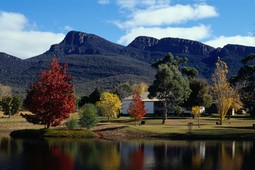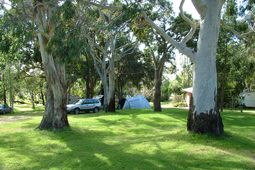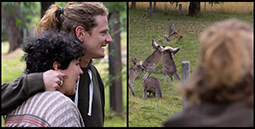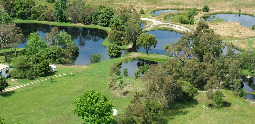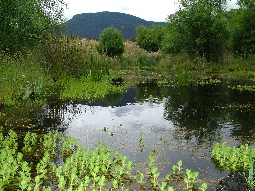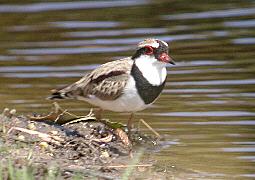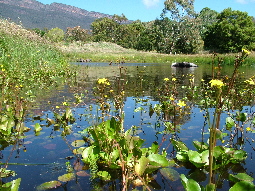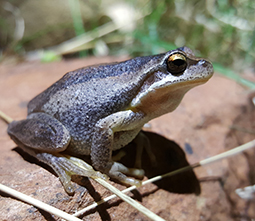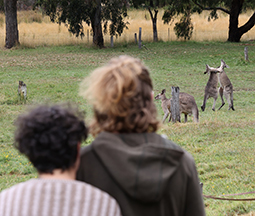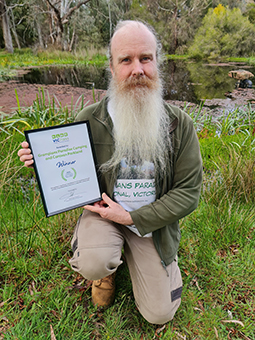

What is An Exclusive Wildlife Stay? Find out on the Exclusive Wildlife Stays Information Page...
If you prefer talking with someone, or you are having difficulties with the online booking page we are very happy to answer your questions by phone or to do a phone booking with you. You can contact us on (03)53566309 or by email or use our Enquiry Form.
- Redman Bluff Wetlands - located at Grampians Paradise
A created wetland ecosystem full of native Australian frogs and wildlife
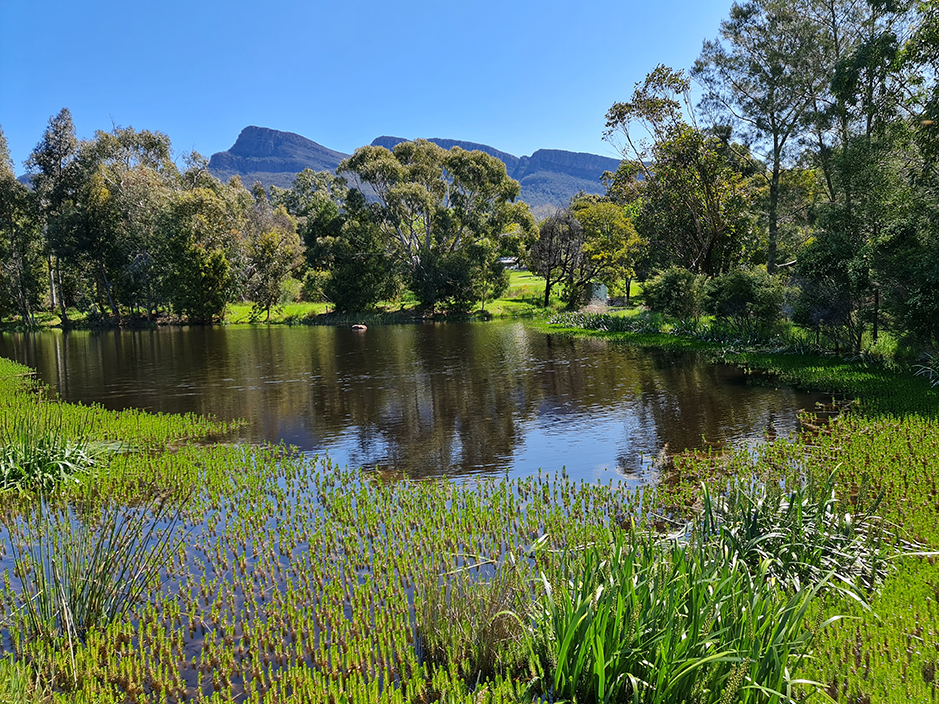
The walk around Blue Lake of the Redman Bluff Wetlands starts right near the edge of the camping grounds of Grampians Paradise Camping and Caravan Parkland.
With beautiful views and lots of habitat for the native Australian birds, frogs
and animals, it is worthwhile to spend an hour or more wondering around the ponds.
The best time of year to see Redman Bluff Wetlands is late winter to early summer.
The best time of year to hear our many frog species is winter and early spring.
The best time of year to watch our native animals is outside of the busy holidays.
"In 2000 I set about a crazy mission to build habitat for native Australian frogs on our property under Redman Bluff of the Grampians National Park. As is fairly typical of my nature, my vision was a little grand. The Redman Bluff Wetlands constructed ecosystem was to be made up of a string of ponds creating different habitat niches for different species of native creatures. 23 years on from the start of the project, and 10 years since its completion of 30 ponds, what a spectacular success. We now may have over one million frogs across 8 different species, not to mention all the other native Australian wildlife that calls our Grampians Paradise home."
Aidan Banfield 14th May 2023 - quote from post in the Field Naturalist Club of Victoria Facebook group.
Redman Bluff Wetlands is recognised as a significant wildlife rewilding project
and has been featured on the #BrightSideNatureNews Facebook Group.
 -ps940px- -as-jpg-.jpg)
#BrightSideNatureNewsNo.32 ![]()
Howdy nature friends,
Redman Bluff Wetlands is a created series of 30 wetlands built to provide habitat for frogs, other animals and birds, and native wetland plants.
In the 23 years since the start, it has achieved this mission and is also home to 2 species of endangered frogs.
It is the result of a mammoth multi-generational family effort, led by Aidan Banfield, who as a small boy was inspired by David Attenborough’s,
“Life on Earth” series. Last year Aidan received a letter of congratulations from the great man himself!
More of this fascinating story of dreams, inspiration, hard work and belief, to be found at: grampiansparadise.com.au
Stay positive...more good news coming your way soon!
#australianwildlife #wildlife #nature #positive #happynews
Read about my (Aidan Banfield's) letter to David Attenborough, and his reply to my story about the wildlife and created ecosystem of Grampians Paradise.
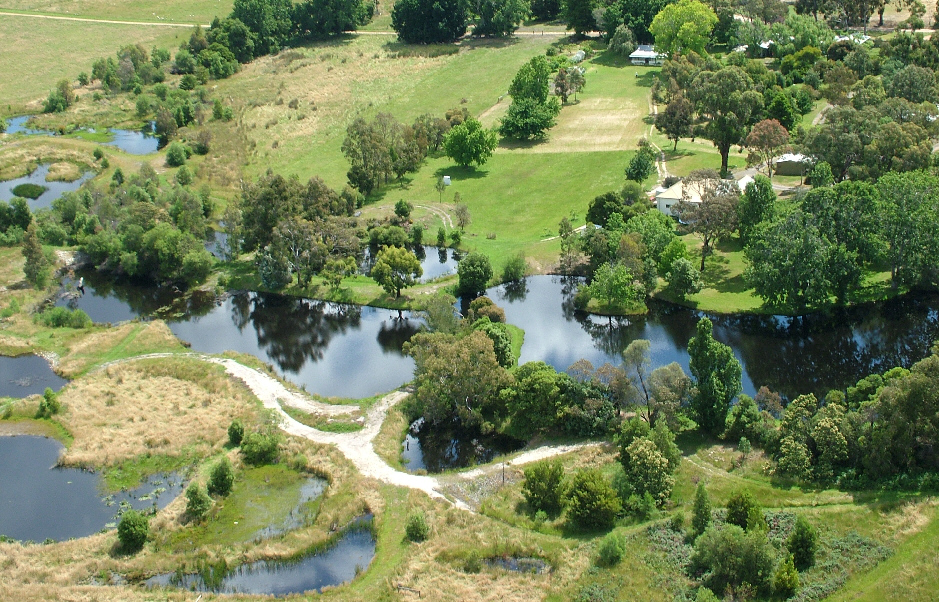
Redman Bluff Wetlands in December 2010. Nearing the end of completing the ponds. The planted wetland plants are establishing, but still have a long way to go.
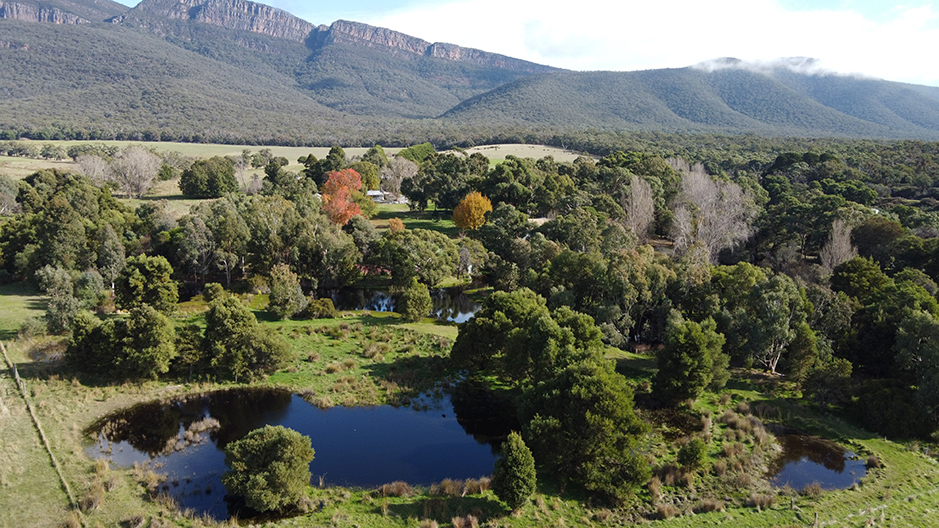
Redman Bluff Wetlands in June 2023. With the trees grown large, large beds of wetland plants flourishing, and the sedges/grasslands well established.
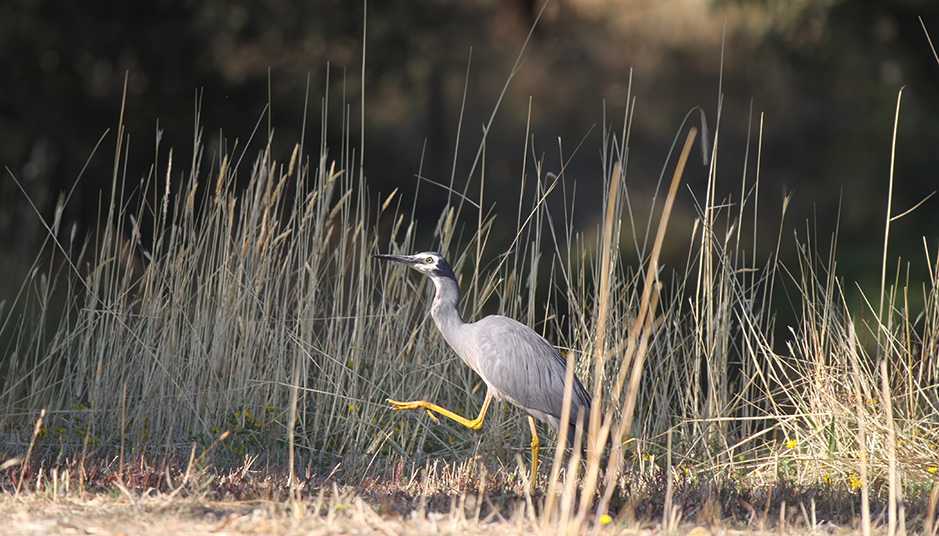
The white-faced heron is one of the more regular visitors of the large wetland birds to Redman Bluff Wetlands.
To Bring back the wildlife, we created Redman Bluff Wetlands:
Grampians Paradise Camping and Caravan Parkland has an amazing amount of native Australian animals, birds and creatures in and around the grounds of our parkland camping ground. But it was not aways like this.
I can remember a time when there were no kangaroos, emus, sugar gliders or ringtail possums about the camping ground. I also remember the numbers of small native birds decreasing between 1980 and 1984... Then there was a turnaround.
Dad, Tom Banfield, had planted about 200 trees and large shrubs in 1980. By 1984 to 1985 these new trees were just big enough to encourage the small birds including superb fairy wrens, white-browed scrub wrens, scarlet robins and others to return and to breed within the grounds of Grampians Paradise.
In the late 1990s I'd been hearing frog populations had been collapsing around the world. I knew we had a few different types of frogs about Grampians Paradise and decided I wanted to do something about it.
In 2000 I dug out Observatory Pond with a restored vintage earth scoop on the back of the 2 wheel drive tractor that we had. It was slow work, taking a month of digging sunrise to sunset to create this first pond of the wetlands.
The success of creating Observatory Pond, and the knowledge already gained that native birds (and presumably native animals and frogs) could be encouraged back to an area by the creation of new habitat, and with inspiration from David Attenborough's 1980's Life on Earth TV series I, Aidan Banfield, and my family set about building the 30 pond Redman Bluff Wetlands and rewilding Grampians Paradise.
Now that more than two decades have passed from the start of the Redman Bluff Wetlands habitat project, we have 8 species of native Australian frogs, two of which are endangered. All of their numbers have increased radically.
With all the new frogs that call Grampians Paradise home, it is amazing to hear their chorus during winter and spring.
Aerial Photos of the building of Redman Bluff Wetlands and though to 2023:
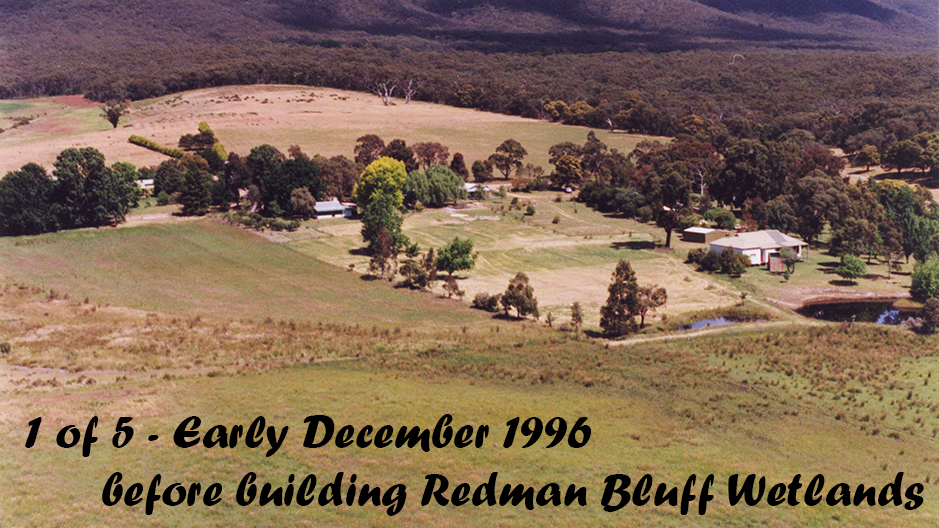
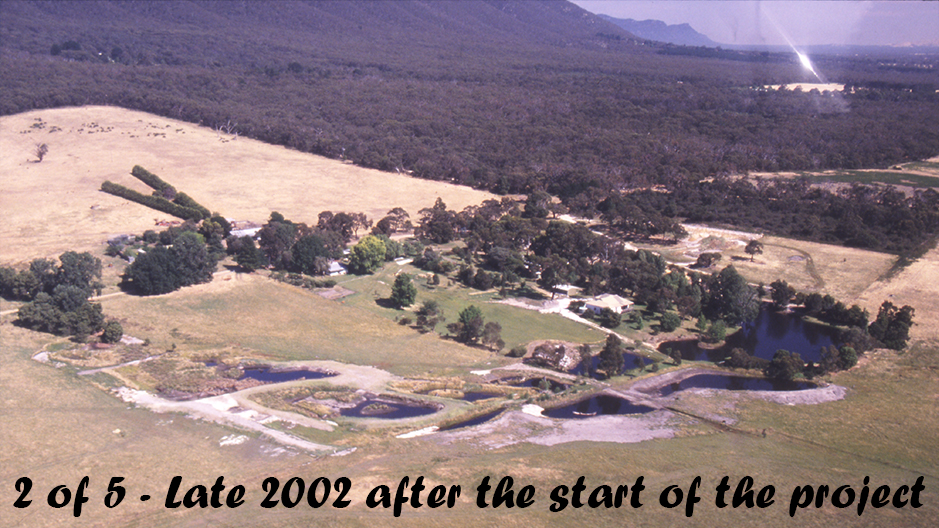
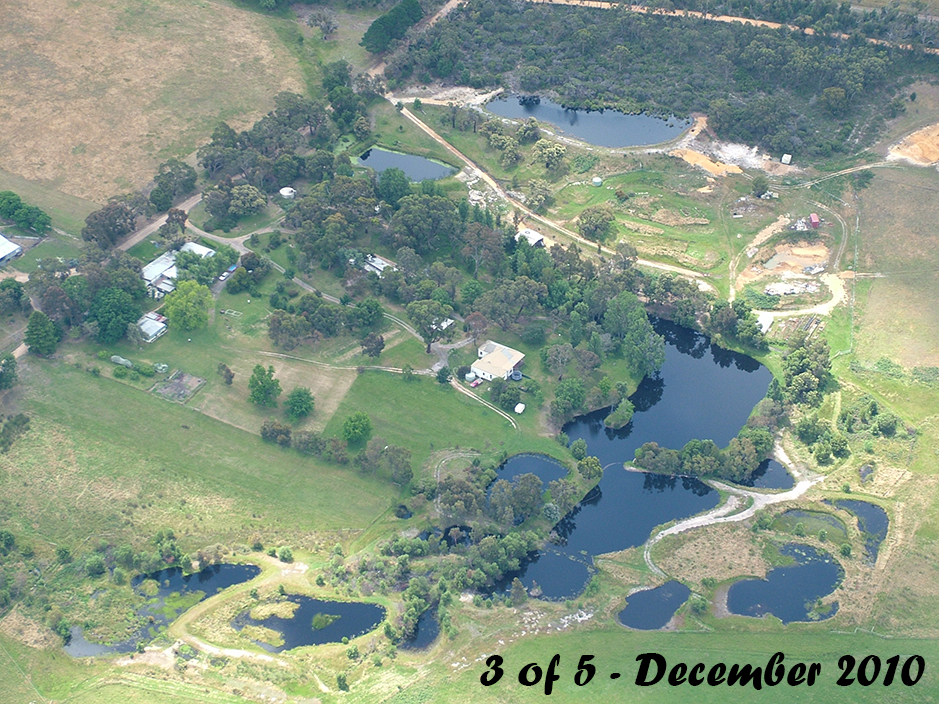
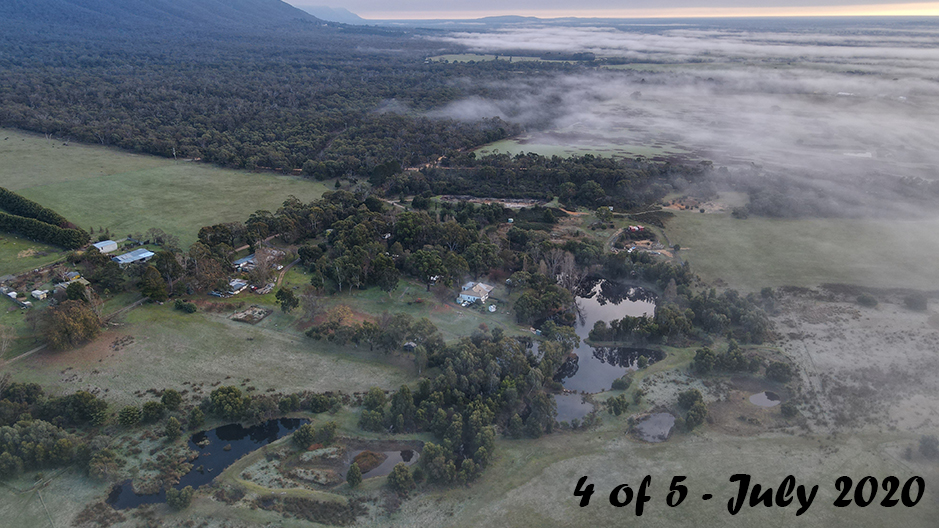
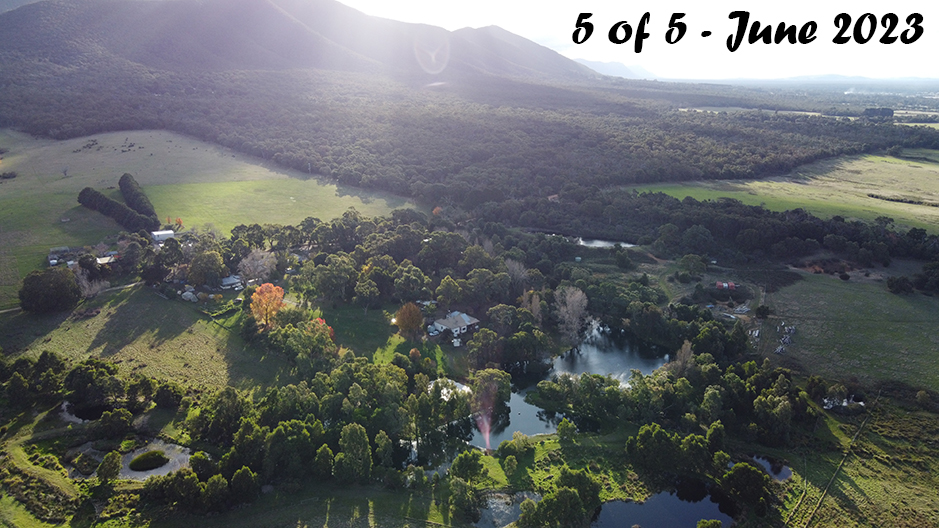
There has been a significant increase in the numbers of native Australian birds:
Over 100 species of native birds have been recorded over the years since 1980 within Grampians Paradise and Redman Bluff Wetlands. Of these around one third are permanent residents and breed here, the next third are seasonal with maybe half of them breeding here. The last third are the occasional visitors.
With the establishment of the Redman Bluff Wetlands and the growth of the 300 or so large trees that have been planted over the last 90 years within the grounds of Grampians paradise, the amount of native birds that our camping ground and surrounding wetlands provide homes and food for is incredible.
It is worthwhile staying at Grampians Paradise just to see the birds. On occasion you may also see our emu that visits the wetlands and camping ground when things are quiet.
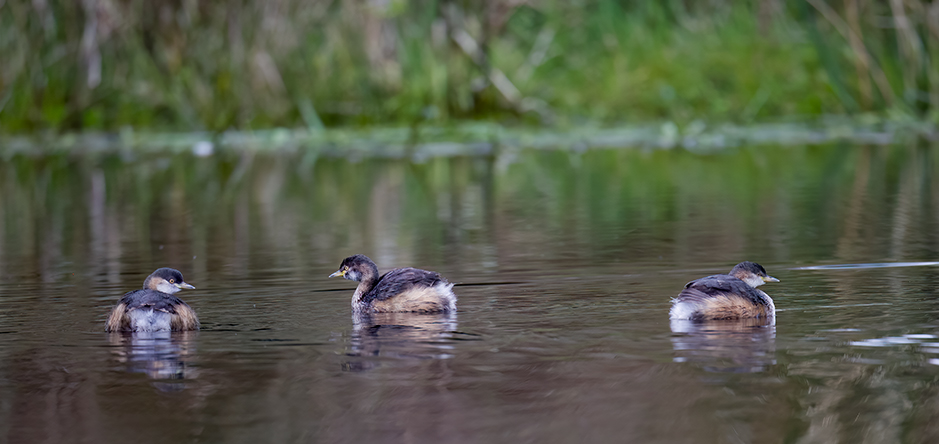
Australasian grebes on "Duck Dinner Wetland", one of the shallow wetland ponds of the created Redman Bluff Wetlands at Grampians Paradise.
Kangaroos, swamp wallabies and other marsupials have taken up residence at Grampians Paradise:
It is not only the birds and frogs that have benefited from all the new habitat that Redman Bluff Wetlands has provided.
Our native marsupials have also done well. The eastern grey kangaroos and swamp wallabies love to shelter amongst the trees and shrubs of the wetlands. They also love the green grass that grows year round on the moist ground between the ponds and grazing the wetland herbs.
Redman Bluff Wetlands provides more than enough cover for our kangaroos and wallabies to feel safe and to spend quite a bit of their time within the grounds of Grampians Paradise.
In addition to these iconic Australian marsupials, we have many other Australian animals that have done well since the establishment of the wetlands. Brush-tailed possums, ring-tailed possums, sugar gliders, echidnas, rakalis and many more.
Night time torch light walks about the camping ground and surround wetlands are really worthwhile to see who you can find.
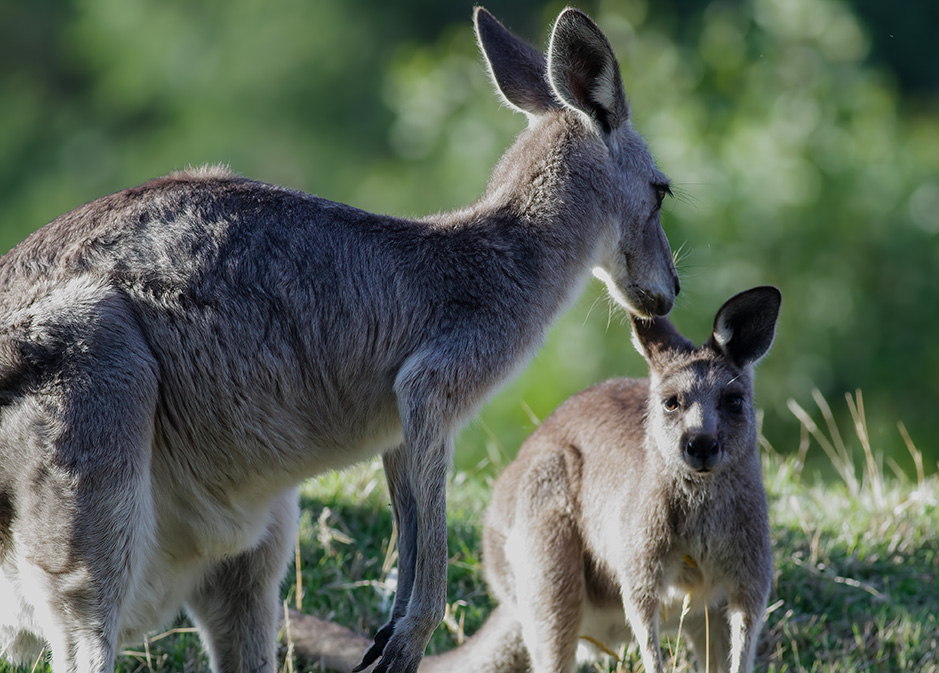
Kangaroos relaxing on the bank of Valley Lake (one of the Redman Bluff Wetlands ponds). This is one of their favorite spot to sunbake and rest.
Inspiration from David Attenborough:
The rewilding of Grampians Paradise and particularly the project of creating the Redman Bluff Wetlands ecosystem, undertaken by my family, has its roots in the inspiration I had received from watching David Attenborough’s Life on Earth TV series in the 1980s. In 2022 I wrote to him to thank him for his inspiration and to let him know that his TV series lead to a new biodiversity hotspot being created at Grampians Paradise. If you would like to read my story of writing to David Attenborough, and his letter in reply, follow this link.
More that a decade on from the completion of the Redman Bluff Wetlands we now have so much native Australian wildlife that call Grampians Paradise Camping and Caravan Parkland home. With the ongoing efforts to continue rewilding the camping ground and surrounding area the numbers of our native creatures are constantly growing.
With time spent quietly watching or walking, you will be able to enjoy seeing many different amazing creatures.
The best time to see our wildlife at Grampians Paradise is outside of the busy holiday times - outside of the long weekends and school holidays, where there are less people staying at Grampians Paradise.
During school term times, we are normally closed on Mondays, Tuesdays and Wednesdays, however you are more than welcome to give us a call (or send us an email) to see if we can open our booking diary for particular mid week school term dates. We often do accept bookings for mid week dates during school term times on request, but bookings for "closed days" can only be made over the phone or by email.
Because it is not possible to make online bookings for days where we would usually be closed**, there are inevitably fewer people staying at Grampians Paradise on mid week days, making it all the better for seeing our wildlife and hearing and seeing our native birds.
** Once closed days are opened for a booking (excluding Exclusive Wildlife Stays), we will open open up online bookings for those days.
If you want to get the best possible wildlife experiences at Grampians Paradise, it would be worthwhile coming on one of our Exclusive Wildlife Stays.
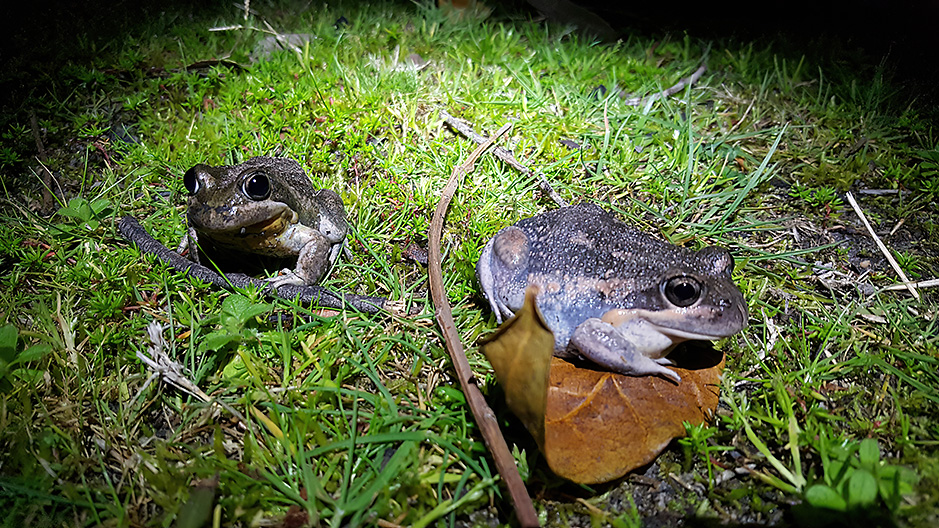
Pobblebonk frogs - Limnodynastes dumerilii - are the second largest frog of the 8 species of native Australian frogs we have at Redman Bluff Wetlands.
A shortened (but not short) history of
creating the 30 pond wetland habitat of Redman Bluff Wetlands.
by Aidan Banfield
In May 2000 the earth was broken at Grampians Paradise with vintage earth moving attachments on our old 2 wheel drive tractor, and with little understanding of how huge a project I was leading our family into, the Redman Bluff Wetlands were starting to be created.
While May 2000 is the start date the creation of a whole new ecosystem, the seed of the project had been developing for years. In 1982 my dad, Tom Banfield, had two little bulldozers in to double the size of the farm dam (Blue Lake) at the bottom of the camping ground. Trees were planted on its banks and over the following years I and my brother would work with dad on changing the shape of some of the edges, even adding an island. This got us in the habit of working with tractors and very basic earth moving attachments, it was just a natural part of life.
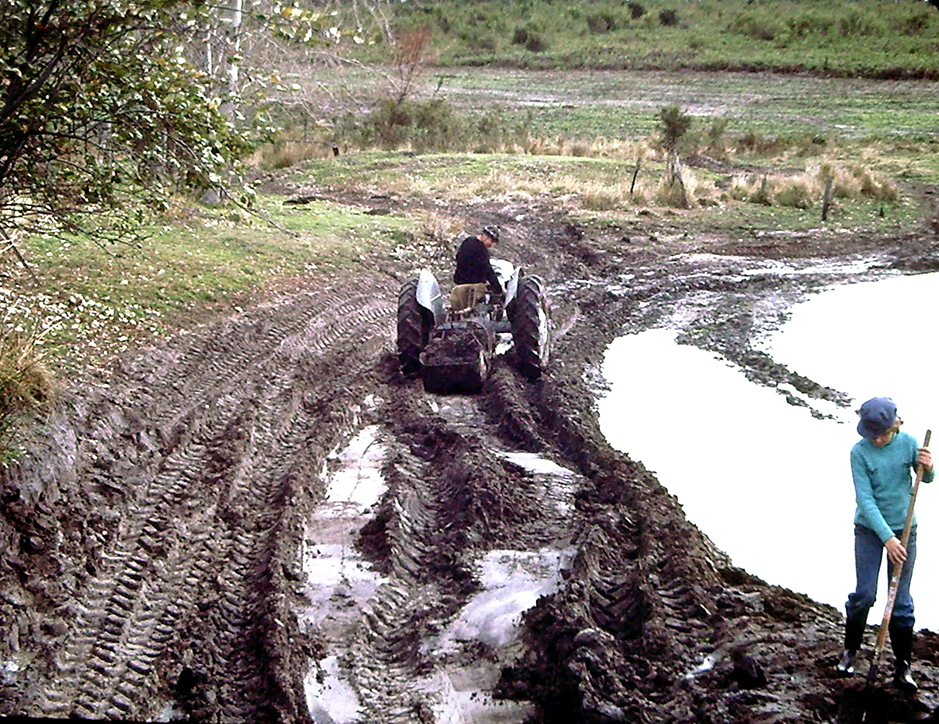
Tom Banfield on our families old "Little Grey Fergie" tractor with earth scoop working on reshaping the edges of Blue Lake somewhere in the mid 1980s.
2000 - Observatory Pond
During the 1990's Dad (Tom Banfield) also talked about digging a chain of shallow ponds upstream of the dam (now called Blue Lake) to filter the water before it arrive at Blue Lake. Dad had dug one very small pond just up stream. So the seeds of an idea were sown, and in May 2000 I enlarged this tiny pond (pictured below - before it was worked on) into Observatory Pond with the equipment we had to hand - the restored old Grey Fergie Earth Scoop on the back of our two wheel drive Fiat Tractor.
With other vintage equipment we had on hand (a harrow, disk plower, ripper and grader blade), a start was also made on Blue Lake South (in 1999 and 2000) and Blue Lake Far South in (2000), both of which would eventually be linked to Blue Lake in May 2008.
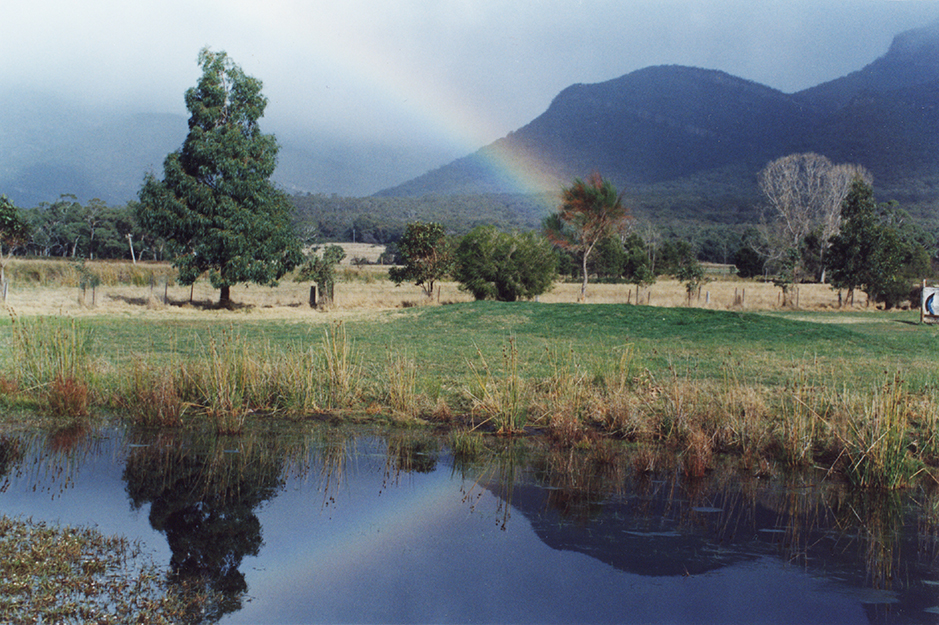
This little pond that was enlarged into Observatory Lake (Pond) in 2000. It was part of the inspiration for the chain of ponds that would form Redman Bluff Wetlands.
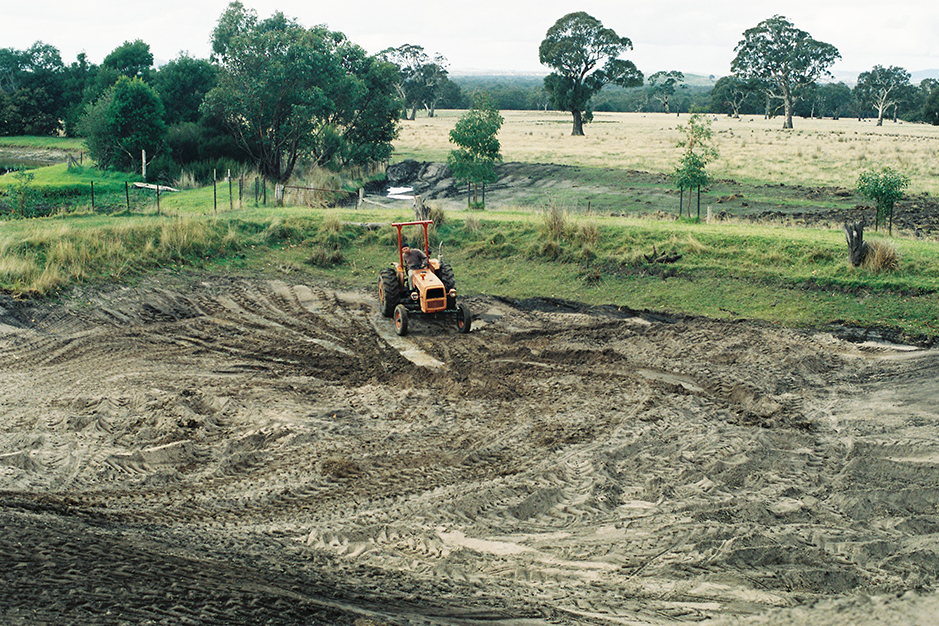
Digging Observatory Pond with a two wheel drive tractor and old earth scoop. In the back ground is Blue Lake South which was also started in 2000.
The other thread that lead to undertaking the creation of the Redman Bluff Wetlands Ecosystem was an environmental one...
I had grown up in a family that had a keen interest in the outdoors and nature. Dad was very keen on native birds and native plants. He even became a lifetime member of the Australian Plants Society. My great aunts were life member of the Field Naturists Club of Victoria. Then in either 1980 or 1979, David Attenborough's Life on Series launched on Australian TV. It expanded my mind and lead to a deep, life long passion for nature.
In May 2000 these two threads (a passion for nature, and love of playing with digging machinery) combined into the starts of a major rewilding project... Redman Bluff Wetlands had been conceived and was starting to grow with a small beginning, the building of Observatory Pond.
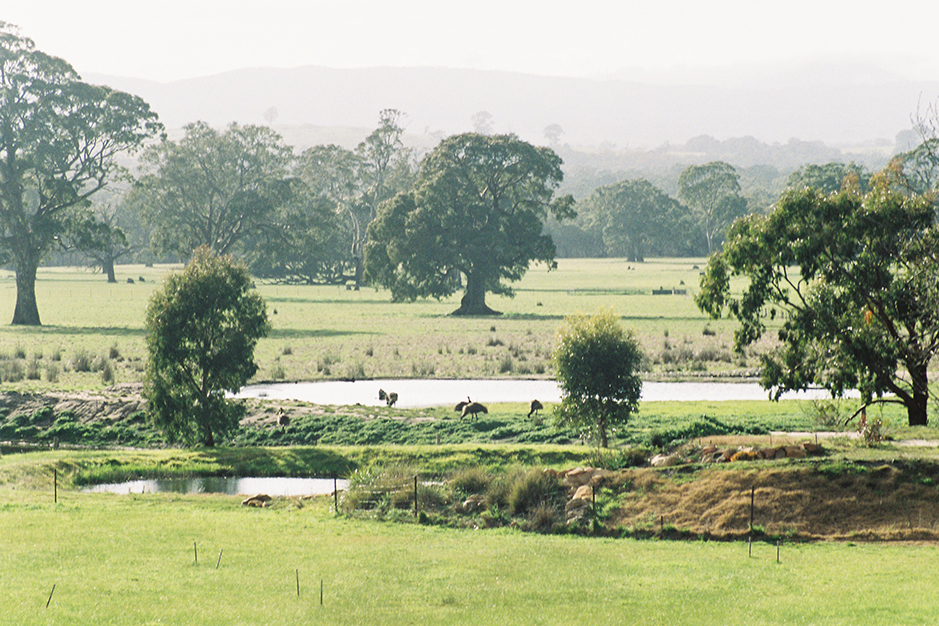
Emus wandering the bank of Blue Lake South, between Observatory Lake and Duck Dinner Wetland during winter 2003, the year Duck Dinner Pond was built.

Spring 2023: A White-necked heron hunts for diner in beds of thick wetland herbs that are now surrounding the island in Observatory Pond.
2001 and 2002 - The String of Ponds
With LandCare Funding secured and the busy summer holiday camping season for Grampians Paradise ended for 2001, a new page in history was about to begin.
Perhaps it is quite fitting that on the 15th January 2001 we officially changed our name from “Redman Bluff Camping Ground” to “Grampians Paradise Camping and Caravan Parkland”. For this marked the start of an era where our focus would become firmly focused on building up the natural environment and sharing its beauty (and wildlife) with those that would stay here.
I was a little sorry to lose the reference to Redman Bluff in the name of our camping ground. Redman Bluff is the third highest mountain of the Grampians National Park and its spectacular large cliffs dominates our western skyline; its summit of 1017 metres being only 2.8 kilometres away from us. It is such an incredible presence in both our landscape and my family’s life. As the reference was no longer in our camping ground name, I felt it was only right that the wetlands we were just about to start building should be call “Redman Bluff Wetlands”.
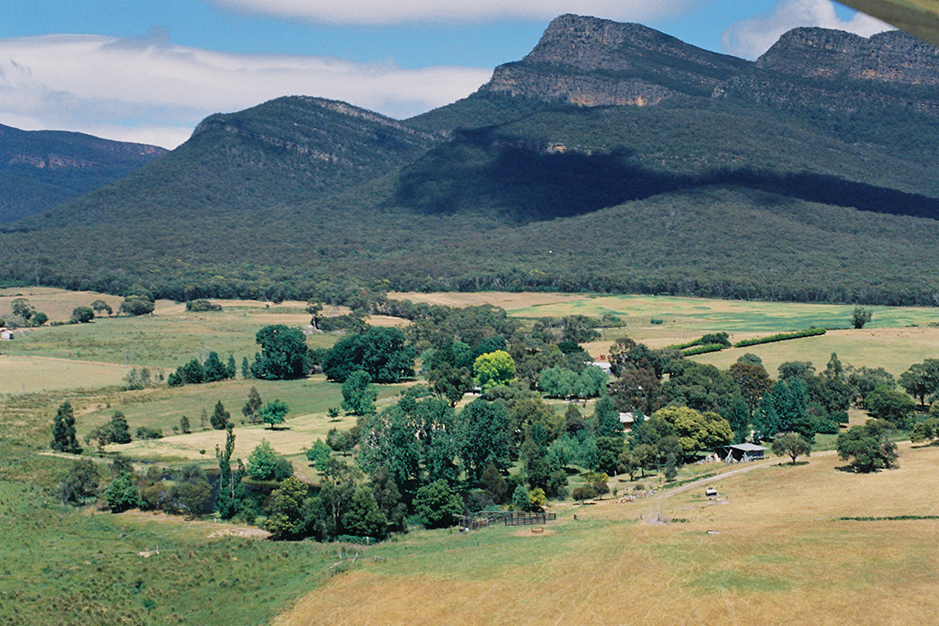
Redman Bluff, the mountain after which Redman Bluff Wetlands is named.
Above photo was taken in early December 1996, four years before the wetlands project was started.
The below photo was taken on 19th June 2023, 11 years after the completion of the 12 year rewilding project. Many of the ponds are now hidden by the trees.

On Sunday 4th March 2001 the earth was broken and a twelve year journey of turning a single wetland pond into a thriving 30 pond wetland ecosystem was started.
It's a big complex story, with thousands of hours spent on earth moving equipment, as well as working by hand, sculpting the land and then planting the wetlands to create habitat. To keep this shorter shorter :) for this web page, I'm leaving out many juicy story's of disaster and success, leading to the ultimate re-wilding of our Grampians Paradise landscape... (I'm am currently writing this story in full and will be published sometime in the future).

Winter 2002: 2nd pond - Wattle Wetlands (centre front), 1st Pond - Kingfisher Ponds (centre middle) Observatory Pond (centre back) have been created.
Blue Lake Far South (right front) and Blue Lake South (right back) have been started. Blue Lake is barely visible right at the back in the centre of the picture.
For 2000 and 2001 a big part (but by no means all) of the works was on creating the sting of ponds, referred to during construction as 1st 2nd, 3rd, 4th, 5th and 6th ponds and then later give their names (see numbers 1 through to 6 on the map and list below).
These chain of ponds were dug out with more modern equipment. These included small to medium excavators, a large bobcat, and a small front end loader and tip truck. The water bodies were created as shallow ponds, that interact with the underling spring-lets and surface creek. These 6 ponds dry out most years during late summer and autumn, before filling reliably in late winter. An annual cycle that suits many wetland herbs, and thus frogs and native creatures that rely on the wetlands full of native semi-aquatic plants.
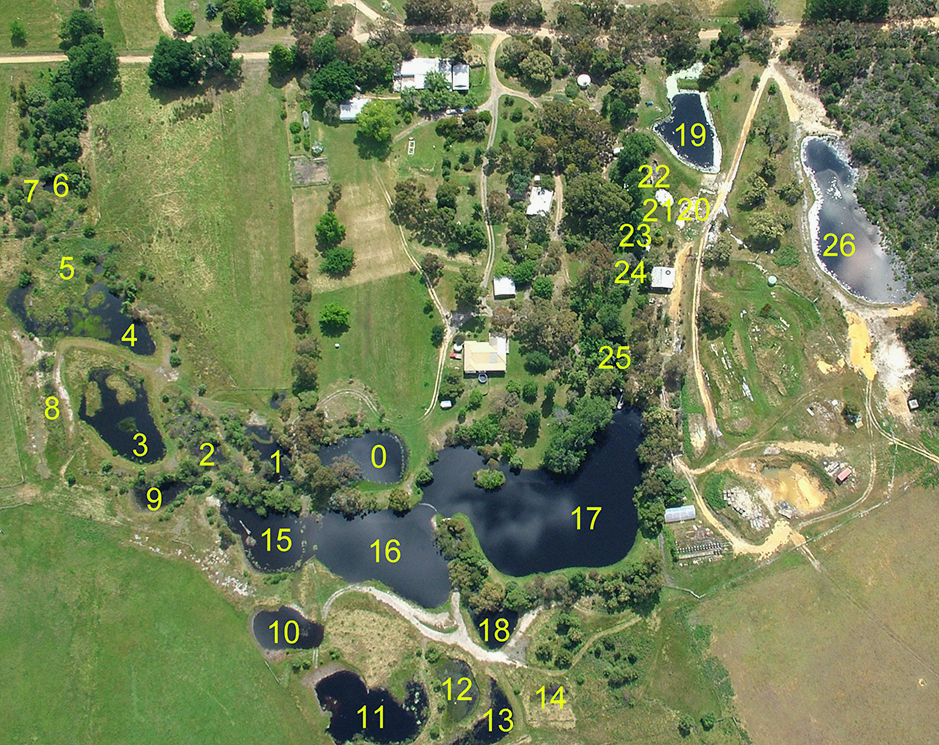
Redman Bluff Wetlands (surrounding Grampians Paradise) in November 2010, 2 years before completion of the project.
LIST OF NAMES OF THE INDIVIUAL WETLAND PONDS OF REMAN BLUFF WETLANDS:
| 0. Observatory Lake | 9. Crescent Billabong | 18. Bass Strait |
| 1. Kingfisher Ponds (2 ponds) | 10. Entrée Pond | 19. Valley Lake |
| 2. Wattle Wetlands (2 ponds) | 11. Duck Dinner Wetland | 20. Cascades |
| 3. Ibis Wetland | 12. Tadpole Soup | 21. Nardoo Pond |
| 4. Snipe Swamp | 13. Pobblebonk Pond | 22. Stone Recharge Pond |
| 5. Swamp Rat Marsh | 14. Mudcake | 23. Meadow Recharge (2 Ponds) |
| 6. Black Duck Pond | 15. Blue Lake Far South | 24. Valley One Pond |
| 7. Hidden Marsh | 16. Blue Lake South | 25. Stone Pond |
| 8. Flood Plain Ponds (2 ponds) | 17. Blue Lake | 26. Fire Wetlands |
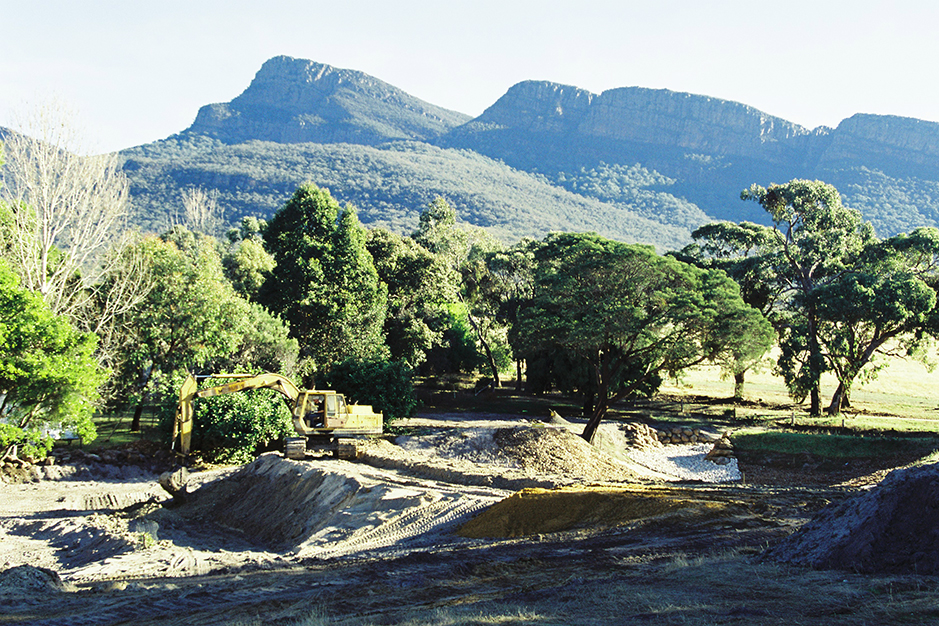
The wall of Valley Lake being built up in May 2002. This followed the building of the stone walls at the ends of the old bank.
The old bank can been see with the stone walls at the back of the pond (to the right of the big Black Wattle Tree - the one with black bark onleft edge of Valley Lake).
2002 - Valley Lake
Before efforts shifted back to completing the string of 6 seasonal wetlands started in 2001, a huge effort was undertaken to create Valley Lake. Extra effort was made to preserve an older bank to provide access to a future timber framed bridge over Valley Lake that is currently being slowly built. The old dam bank was built by hand by my Grandfather Walter Banfield and Great Grandfather Harry Hill Banfield somewhere between 9011 and the early 1930's. My dad, Tom Banfield, told the story of this little dam:
"A smaller dam on the west boundary ("Valley Dam") was built on a sandy gully and never held water. The track from the entrance of the property (south east corner [of the farm]) ran up through the bush and crossed the creek by this dam. I can remember coming in this way as a child. Early in the 1940's the bank failed and the bank was abandoned as road access."
As I (Aidan Banfield) remember from my childhood, the little dam would only hold a very small amount of water during a wet winter / spring and then would dry up as soon as the spring rains came to an end. In the early days it's bank had however been very important as access to the original cottage and the house paddock (the site of Grampians Paradise).
Before the time of the second world war, Long Gully Rd (the access to Grampians Paradise) did not exist. On the drive out in the Model A Ford to the property, the Banfield's would leave the end of Redman Road somewhere below the eastern edge of our property and drive the last 1.5 kilometres through the paddocks (then uncleared of bush), staying north of the creek that flows the full length of our farm. In these pre World War II days, driving over the narrow old "Valley Dam" bank was the only place to cross the creek that divided our property in two.
Because the old Valley Dam bank was such an important part of the story of the history of Redman Farm and Grampians Paradise I wanted to preserve most of it when creating the new Valley Lake.
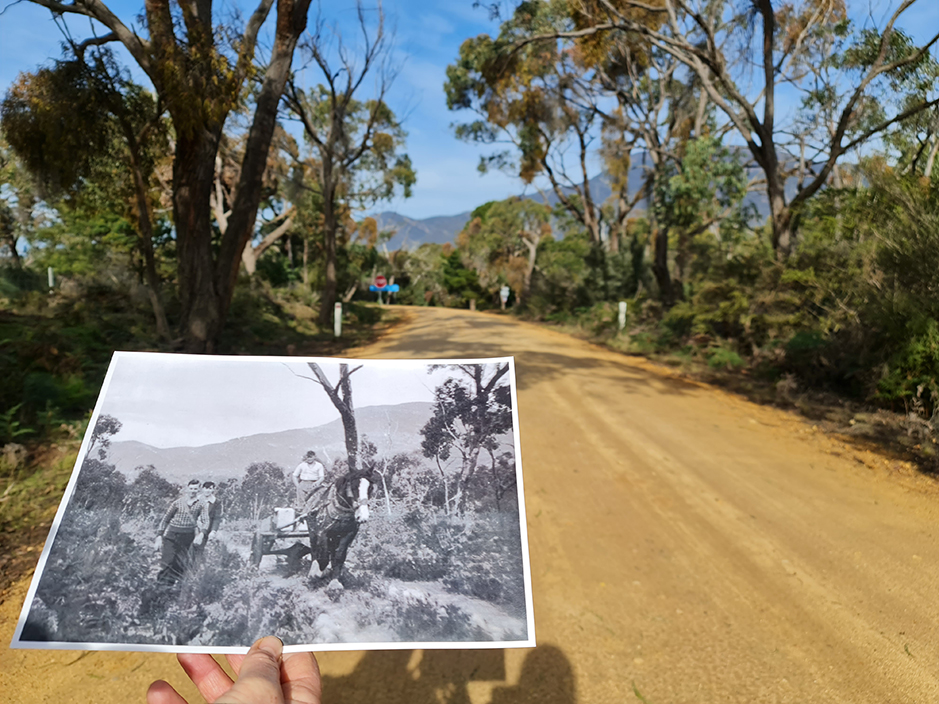
Long Gully Road, the access to Grampians Paradise did not exist in the 1930s before the Second World War. Even in 1949 to 1953 it was just a cart track.
Considerable effort was put into preserving the majority of the bank, with two dry rocks walls of multi ton stone being built in late April 2002 to stabilizing the ends of the wall where a 22 foot (6.7 metre) span timber bridge will eventually span the missing gap in the old wall.
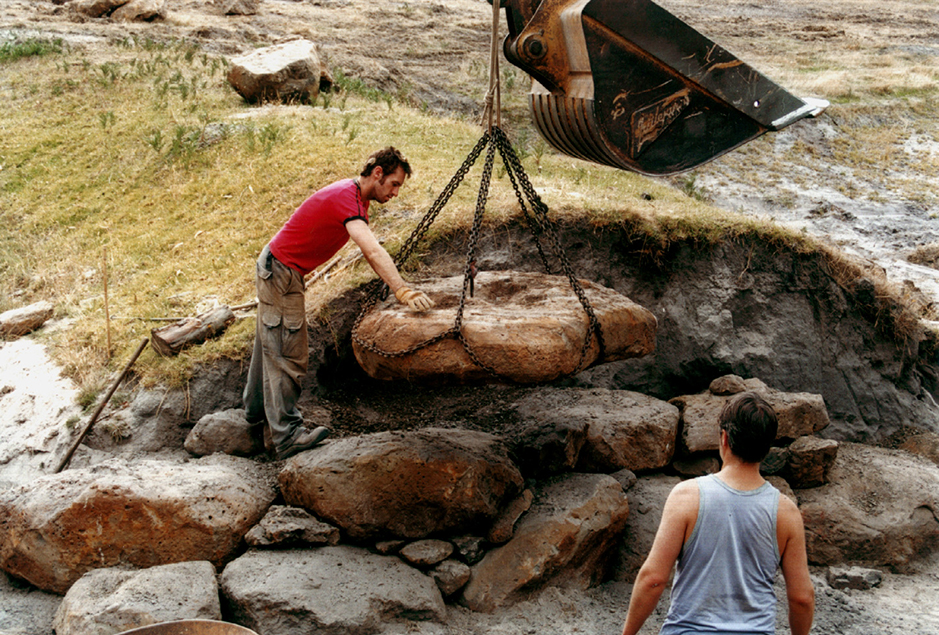
April 2002: Building one of the two stone walls at the end of the old dam bank in Valley Lake. These walls will form the foundation for a wooden bridge.
The old wall also provided for a wonderful shallow wetlands section in the western part of Valley Lake. Once the stone wall work was finished, Valley Lake was dug out, and the new large bank build 50 metres down stream. This took a full month to complete ending in early June 2002.
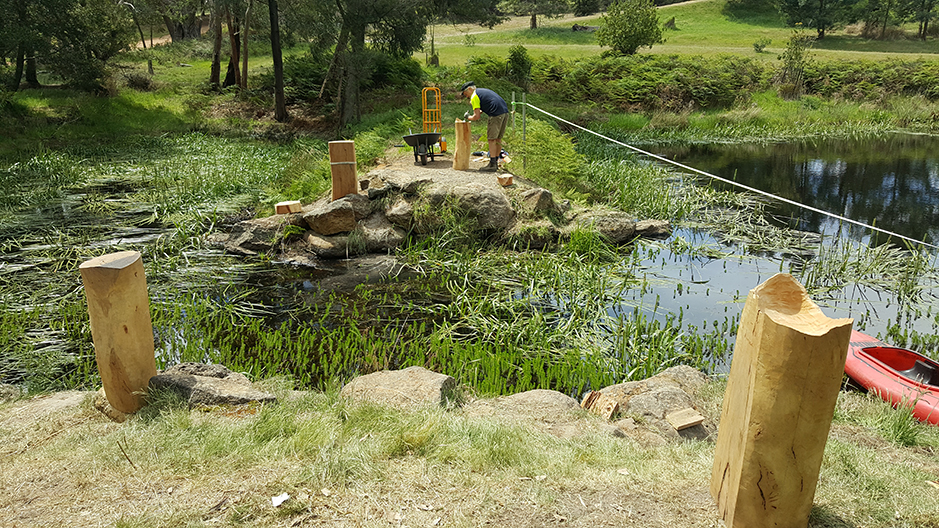
October 2018: The shallow wetlands behind the old dam bank in Valley Lake is well established with native wetland plants flourishing, providing great frog habitat.
The stumps being carved are for a substantial timber framed bridge that will span the
22 foot (6.7 metre) gap.
A big part of the work to make Valley Lake was finding sufficient clay for Valley Lakes wall. It was hard going to find enough, and lead to clay being extracted from Observatory Lake, the south end of Blue Lake, and the start of another pond, Fire Wetlands which is now the deepest pond at 6.5 metres depth.
This was only part of the works for 2002. Work also continued on Blue Lake South and Blue Lake Far South (the future extensions to make Blue Lake 200 metres long), as well as completing the string of 6 ponds started in 2001.
Like in 2001, 2002 had been a huge year on building the wetlands. Good success was starting to show. The dream of Redman Bluff Wetlands was becoming a reality, and it would be only a few more years before the benefit for the frogs and wildlife of Grampians Paradise would be very apparent, though the project would in large, not be completed until 2012.
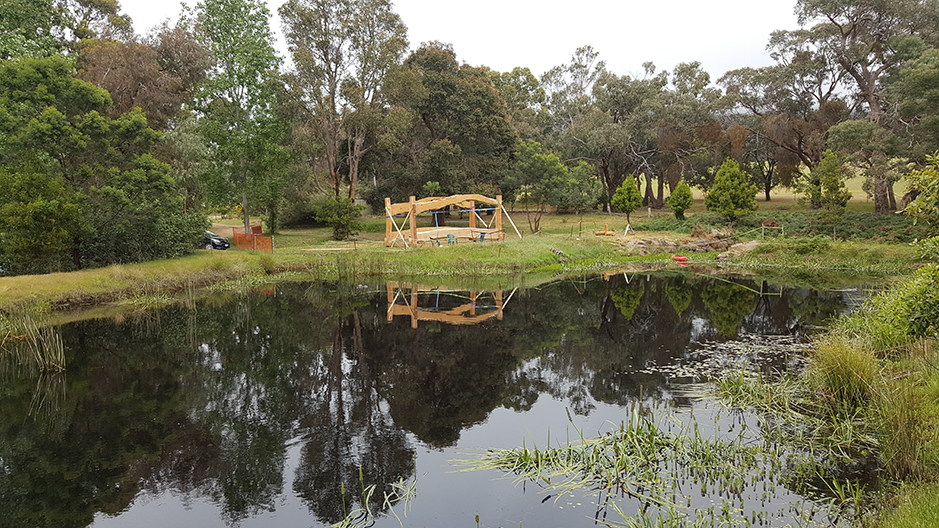
October 2018: Valley Lake is well established with lush beds of wetland plants that support native frogs, fish, birds and other native creatures.
The large timber frame reflected in Valley Lake, is the 4.5 ton main frame of the 6.7 metre long bridge that will span the gap in the old bank.
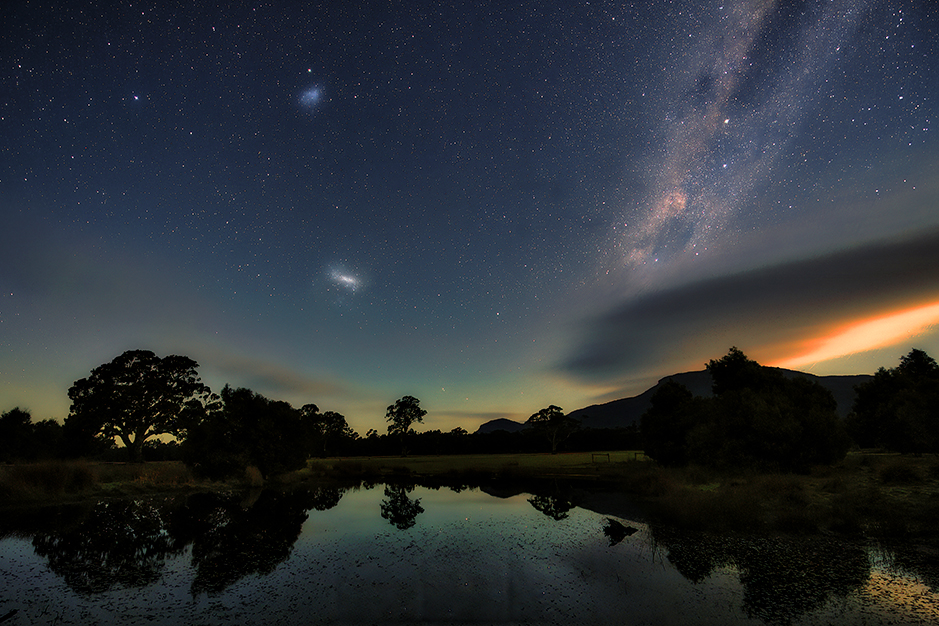
Night view of the Milky Way and Magellanic Clouds with Duck Dinner Wetland in the foreground. This view is a very short walk from Grampians Paradise.
The Milky Way core is over
Mt. William, the tallest mountain of the Grampians National Park. This photo was taken on 14th August 2021 at around 11pm
2003 - Duck Dinner Plain and the building of its shallow wetland ponds
When I started to build Redman Bluff Wetlands, I had little understanding of wetlands and how they worked to provide habitat for wildlife.
While working on digging the wetlands, I was also spending much time on learning about the ecology of wetlands and how life within them functions. I very quickly gained an increasing understanding that native wetland plants (millions of them) would be needed to bring the wetlands to life and provide the food and cover the frogs and other creatures would need.
I also discovered many native Australian Wetland Plants like only to be in water for part of the year and only grow in shallow water. To get big beds of wetland plants, the distance between the waters edge to 30 centimetres deep, needs to be as big as possible.
As it turned out, building wetlands with such shallow gradients into the water is comparatively easy with far less depth of dirt needing to be moved. That such shallow ponds would not hold water year round was just what was needed to sustain large beds of semi-aquatic wetland herbs.
With this new understanding the ponds of Duck Dinner Plain were built to the east of Blue Lake in March 2003.
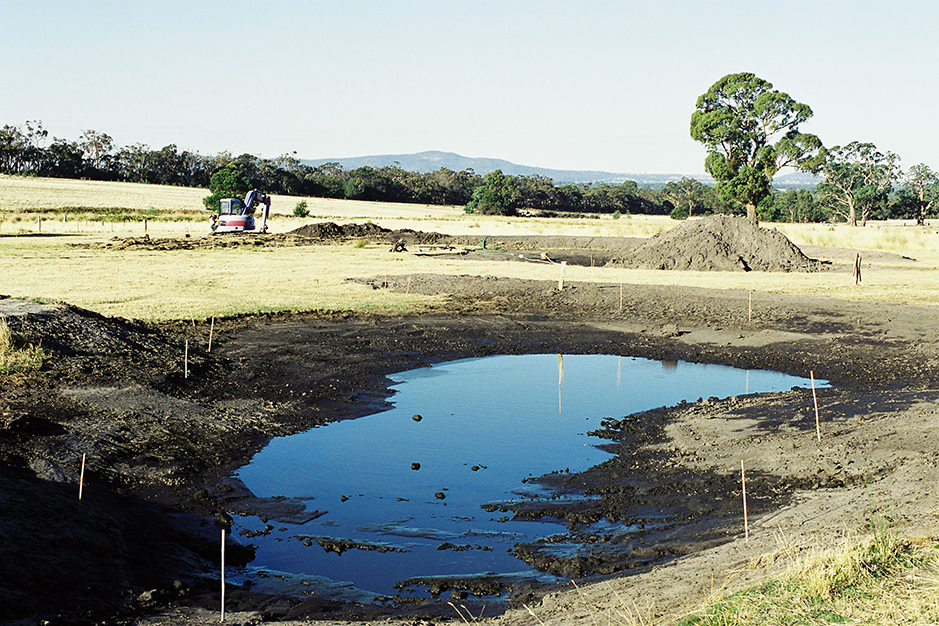
March 2003, the duck dinner plains ponds are dug: "Entrée" pond is spring feed. "Duck Dinner Wetland" (the one with dirt pile is the largest.
The excavator is working on the flat bottomed pond "Tadpole Soup". It is only 15 centimeters deep and now full of wetland herbs.
The digging and shaping of Duck Dinner Ponds was a relatively easy process. Spillways were then built, and the banks sown down with grass.
Over the spring of 2003 and 2004, some native wetland plants established from seed that were finding there own way to new ponds, but this was a slow process, so in 2009 efforts were made to plant several hundred new plants including running marsh flower, water ribbons, pond weed and many other interesting species of native (indigenous) wetland herb.
Right from the start, these new planted plants thrived and by 2010 had reproduced into thousands (maybe millions) of individuals, forming thick beds of wetland plants. Each spring and early summer the growth is at is peak as the frog breading season draws to a close.
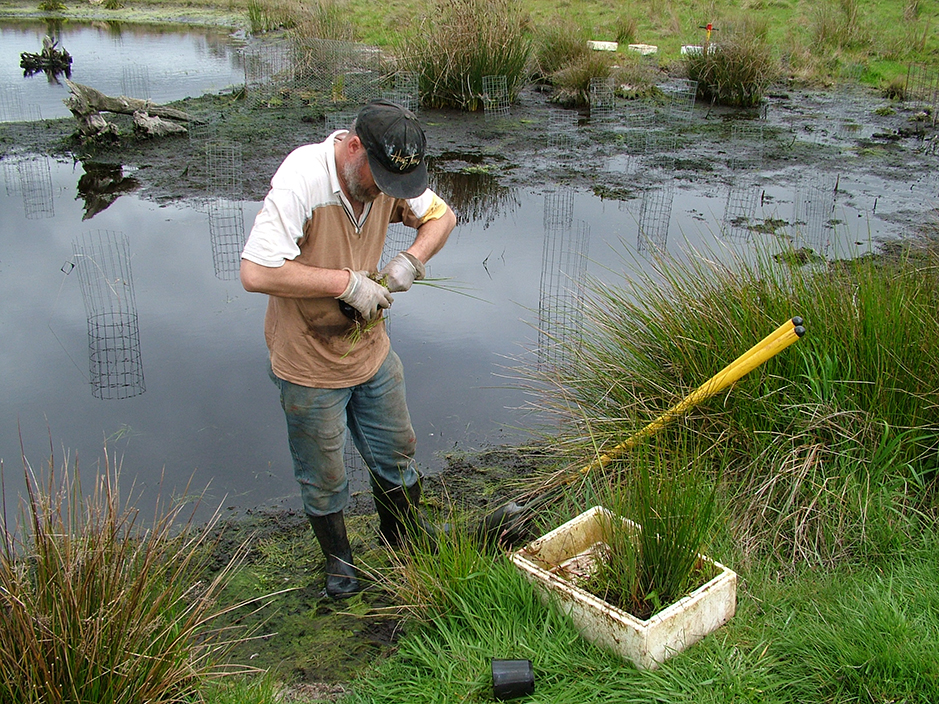
September 2005: Wetland sedges, rushes and herbs are planted into Duck Dinner Wetland to provide Flora for Fauna and create wetland habitat.
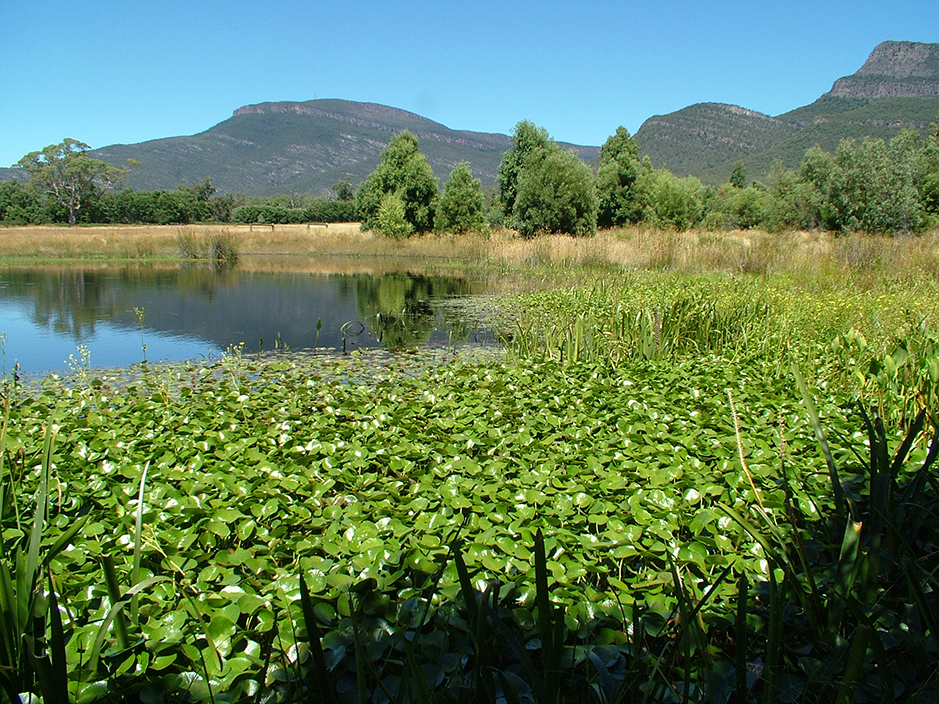
Duck Dinner Wetland in 2017 with thick beds of Running Marsh Flowers punctuated by Water Ribbons and other native wetland herbs.
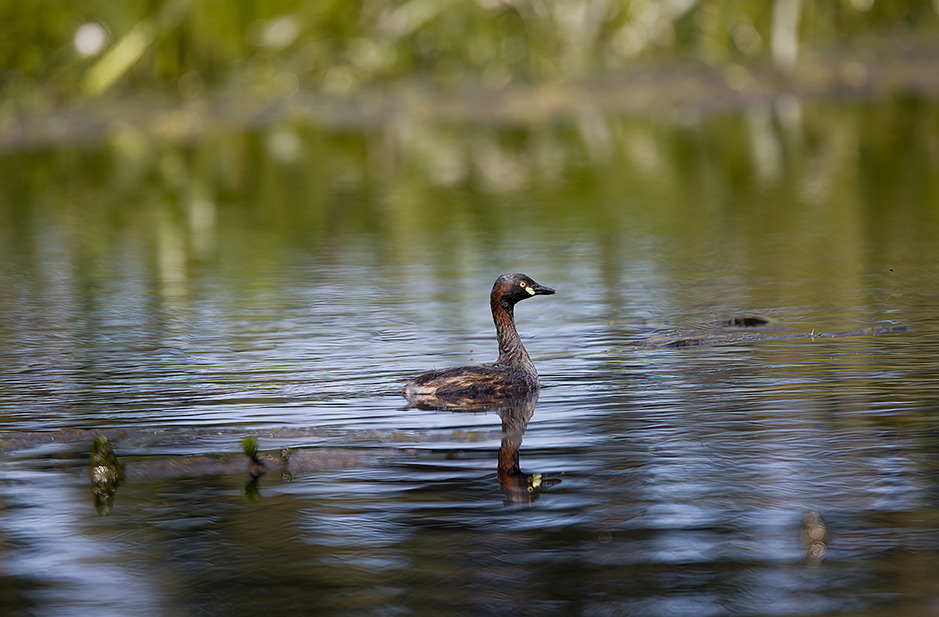
Spring 2023: Australasian grebe in breeding plumage on Duck Dinner Wetland. I got to watch and photograph this amazing diving bird for around half an hour.
2004 - The Cascades
Valley Lake was competed in 2003, having survived its inaugural winter fill and with the first wetland plants planted in it in 2003 it was starting to look like it would become a wonderful wetland ecosystem.
It was however very vulnerable to loosing its bank to erosion (just as the original small Valley Dam had done some 60 years prior). It was imperative that a safe way for flood waters to drop the vertical 4 metres down to the creek through the camping ground was created - there was no overflow structure for Valley Lake for that first year.
Rather than create a concrete overflow and water-chute, I wanted to do sometime more creative, that in time would look more natural. The decision was made to use reasonably sized dry stacked boulders, packed with crushed rock behind, and to create a series of small ponds and cascades to take the energy of the descending flood water. During 2004, on six separate occasions, large rocks were carefully lifted into place to create the overflow structure for Valley Lake.
While still not finished, sufficient work has been competed for The Cascades to handled two of the biggest flood flows in the last 112 years, 2011 and 2022.
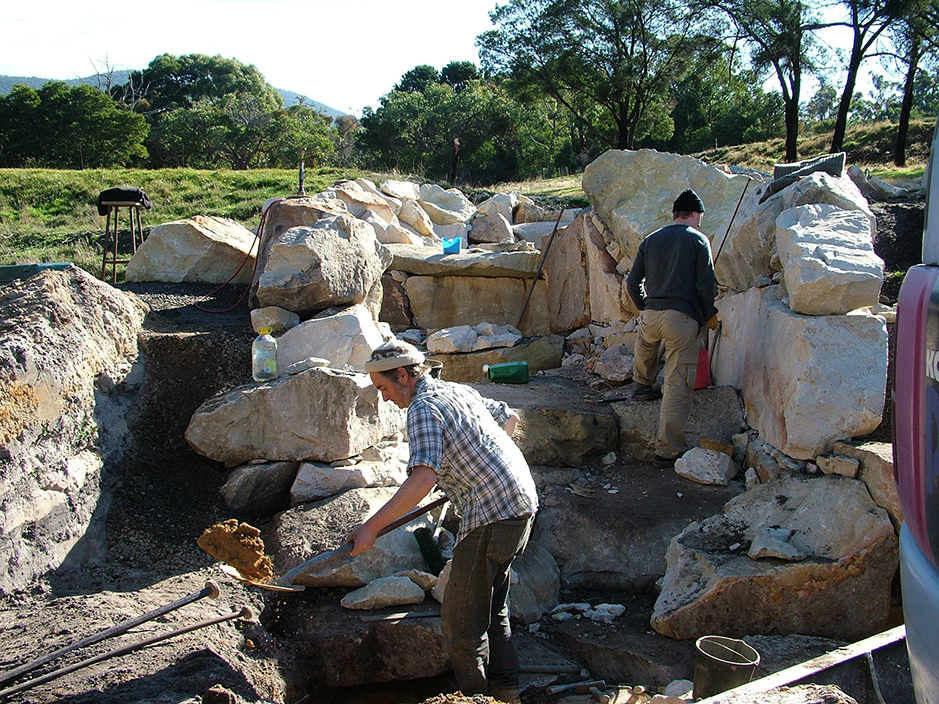
June 2004: Many of the large sandstone rocks had already been lifted into place to make the Cascades. This waterfall carries overflow water from Valley Lake.
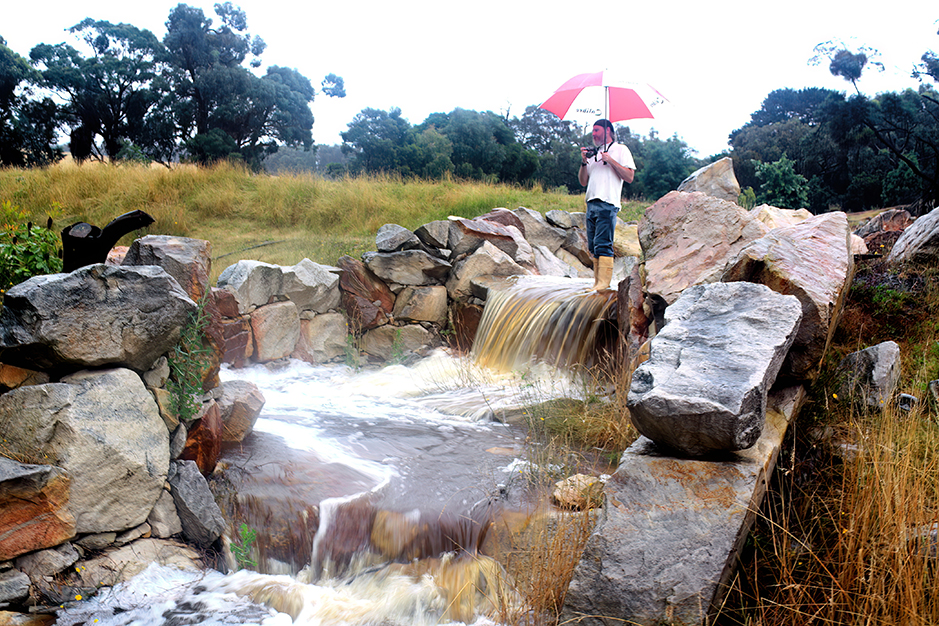
13th January 2011: The peak flow had already passed with the January 2011 flood, but this picture shows the Cascades working as designed.
Growing plants for wetlands:
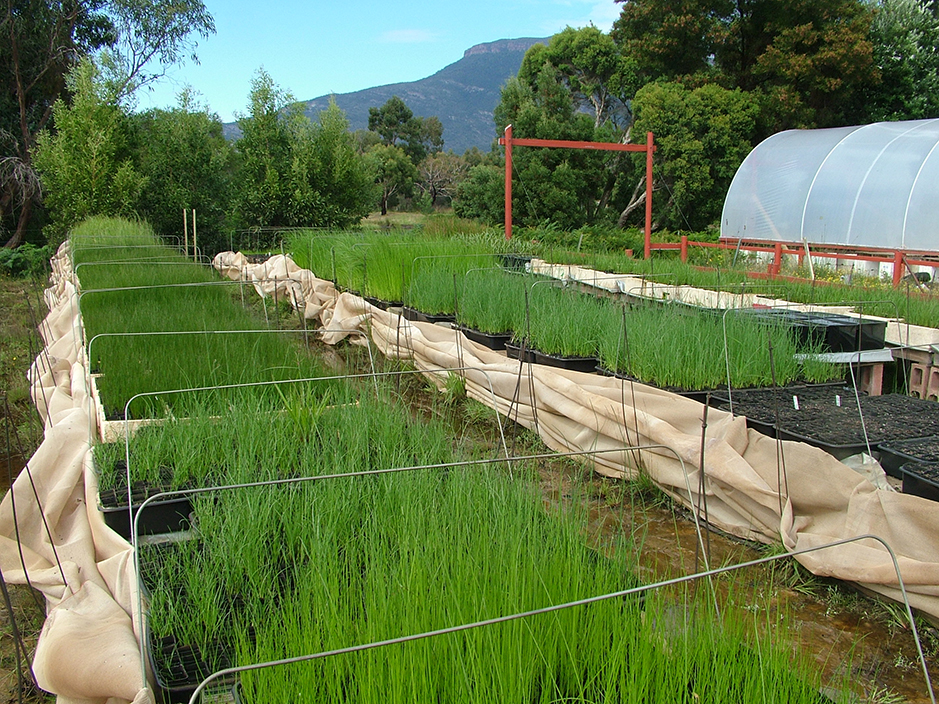
February 2011: Part of our Wetlands Creations nursery (closed down in 2014). Many of these wetland plants were ready for delivery to wetland projects throughout Victoria.
Some were also be used for our Redman Bluff Wetlands to help build up the habitat for many native creatures that rely on our Redman Bluff Wetlands.
2001 to 2014 - growing wetland plants and the Wetlands Creations wetland plant nursery
It is one thing to dig a pond, even better shallow ones that are more suited to wetlands. But without wetland plants, all you are going to have is a body of water. To turn any body of water into a wetland ecosystem, you need plants in and around the water. And you need so many, enough to form carpets of herbs and fields of sedges to provide for the creatures that are needed to create a wetland ecosystem.
But to get these native wetland plants turned out to be not so easy. I had little to no knowledge of wetland plants when in 2000 I started the Redman Bluff Wetlands rewilding project. There was very little knowledge about wetland plants within the local native plant community and nursery people. There was also no local nursery where we could buy the wetland plants from.
In 2001 I tried to solve this problem by growing a couple of species of wetland plants. Despite my previous experience in grown native Australian plants and trees, my success was poor in this first year, but just enough to get things started.

November 2008: Planting wetland plants including running marsh flower Ornduffia reniformis (formerly known as Villarsia reniformis) into Blue Lake Far South.
These plants were grown in our wetland plant nursery Wetlands Creations, and were important for turning the ponds into thriving wetland ecosystems.
In 2002 I started forming connections with some environment people from Ballarat, one who grow wetland plants, and another with knowledge of which plants different wetland creatures relied on. My knowledge of the world of wetland plants and wetland ecosystems began to expand rapidly, and by halfway through 2003 we had a small wetland plant nursery up and running.
While my initial intension was just to grow plants for our Redman Bluff Wetland project, it quickly become apparent there were other wetland projects in a similar predicament as us of not being able to acquire wetland plants.
In October 2003, our first consumer, one of the City Councils in our region, purchased several thousands of plants (maybe 6000 plants), nearly all our stock for 2003 for their wetland project. Still it got things off to a good start, and by the mid 2000's our Wetlands Creations Nursery was producing around 30,000 plants per year.
While most of these were being sold, there was enough each year to undertake significant planting of our Redman Bluff Wetland ponds. While the numbers of plants being planted into our own wetland ponds was a small fraction of what we were selling, fortunately most of what we planted flourished and expanded into massive beds of millions of wetland herbs and sedges, which now help to support a vast number of native frogs, birds and other native animals and creatures.
Our Wetlands Creations nursery continued operating for another 2 years beyond the completion in 2012 of the Redman Bluff wetland project. The nursery was wound up in 2014.
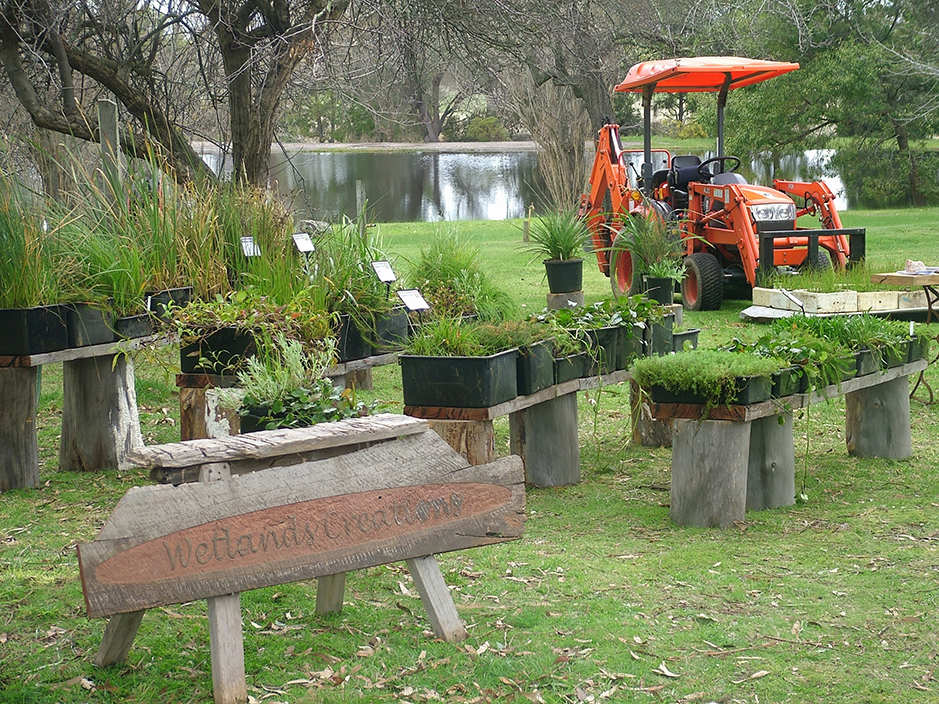
A display of wetland plants set at Grampians Paradise in August 2012. This gives a good representation of the wetland plants we grew at our Wetlands Creations Nursery.

March 2011: A tiny green spider on one of the rushes (Eleocharis acuta) growing in our wetland plant nursery. The stem it is only is about 4mm diameter.
These tiny little spiders can be found on rushes in and about Redman Bluff Wetlands.
Fire Wetland - one of 30 ponds of Redman Bluff Wetlands:
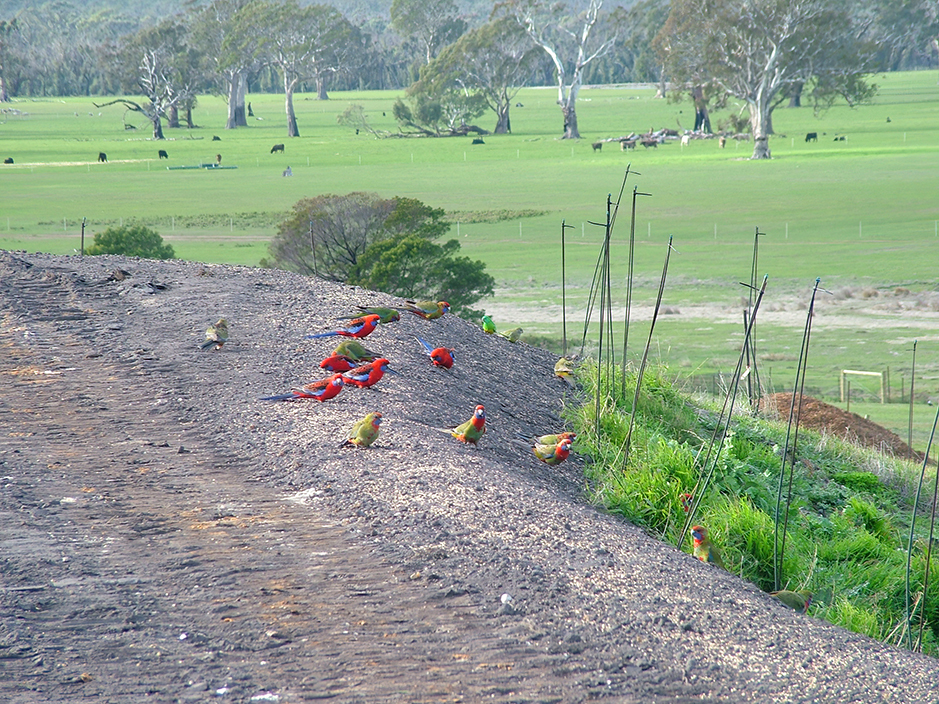
Crimson Rosella's enjoying some of the grass seed sown on Fire Wetland Bank in July 2007. We sowed enough seed for the birds to have their share.
2001 to 2007 - Building Fire Wetland
The building of Fire Wetland was a long journey of disjointed works each year between 2001 and 2007 (with the exclusion of a break year in 2003). While Fire Wetland was an original part of the plan of Redman Bluff Wetlands, the thinking was it would be a later part of the project. This is not how things played out.
In July 2001, 600 cubic metres of clay sands were removed from the north end of Blue Lake. As this material turned out to be not of a high enough quality to use for Valley Lake wall, it was used for the outside edge of Fire Wetland's wall - Fire Wetland affectively started a "dump" for unwanted earth...
In April 2002, the top soil was lifted off the site of Fire Wetland. This was done so that I could learn to use a 15 ton Excavator with reversed controls away from the danger of damaging anything. Then in May 2002 Valley Lake was dug out. Unfortunately, like the north end of Blue Lake, the earth was also not suitable for the 4 metre thick clay bank liner for Valley Lake. All but 10 truck loads of material removed from Valley Lake was trucked the short distance up the hill to form the southern bank Fire Wetland. Once again, Fire Wetland bank was being built as a way of getting rid of waste earth.
As soon as Valley Lake had been dug out, there was a desperate need for clay to build Valley Lake wall.
Accessibly clay form the southern end of Blue Lake, and Observatory Lake were quickly exhausted. The only other location that the necessary clay could be obtained was from the base of Fire Wetland. The Fire Wetland was now being dug out to provide good clay sand for Valley Lake Wall.
By the end of the wetland building season for 2002, Fire Wetland was well on the way to becoming a reality, but there was still so much work to do before it would become a functional pond.
It took many sessions of building, and hundreds of hours over the next five years (when equipment and money were available) to complete Fire Wetland, and turn it from what had been effectively a dump and mine for earth, into a valuable wetland pond, one of 30 that makes up the Redman Bluff Wetlands.
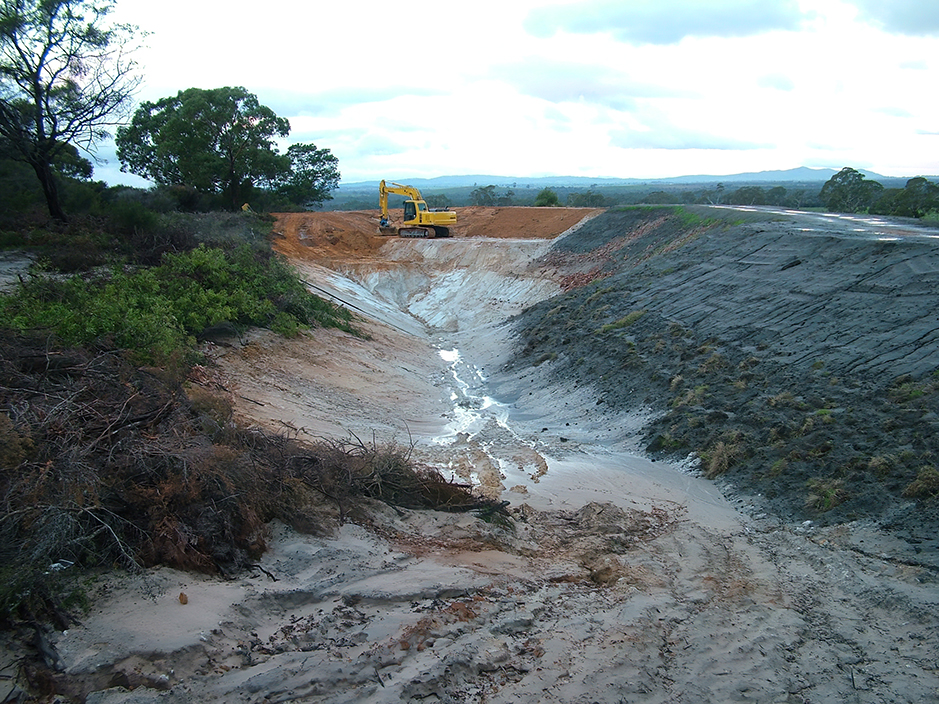
July 2007, just 2 months before the completion of Fire Wetland and its first fill in September 2007. The bank have been top dressed and organic material added to the shallow slopes.
Why the name Fire Wetland? The pond is quite long, around 70 metres and forms a barrier to bush fire approaching Grampians Paradise from the north - therefore it was named Fire Wetland.
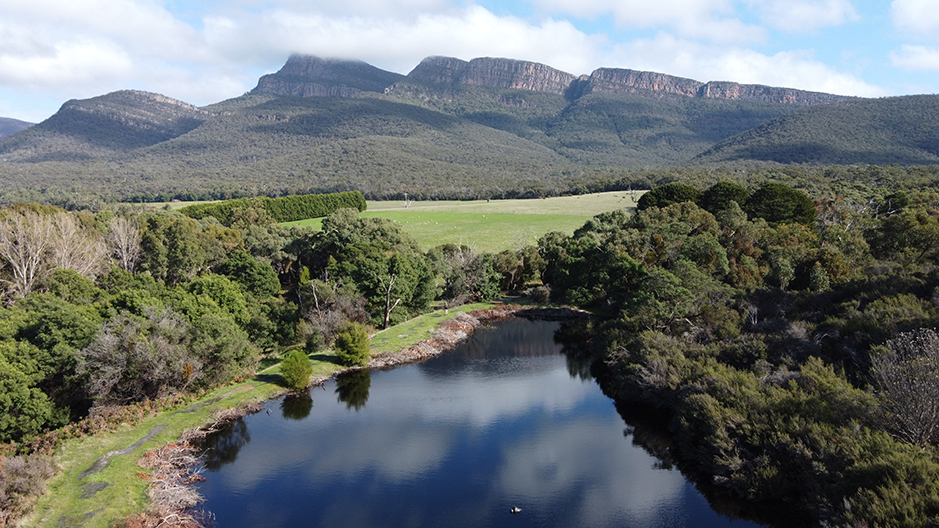
2023 Fire Wetland full, with Redman Bluff and Long Gully Cliffs behind. The summit of Redman Bluff is just 2.8 kelometres away.
Blue Lake grows to include wetlands:
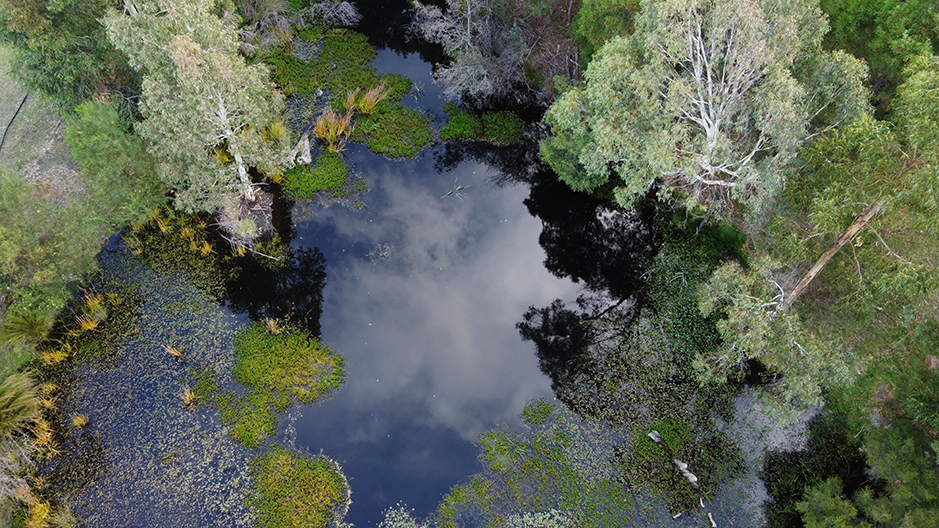
Drone photo: Blue Lake Far South in late May 2023. This the southern spring fed section of the 200 metre long Blue Lake beside Grampians Paradise.
Blue Lake is not normally full in Autumn, 2021 was a flood year. The wetland plant growth seen is this picture is more typical of early spring growth.
1999 to 2012 - Extending Blue Lake to include new wetland sections
During the late 1990’s many, many times there were discussions with Tom Banfield (my Dad) about future ponds.
These talks and walks over the ground focused on three areas, and formed the foundation for the concept of the Redman Bluff Wetlands.
1) The wet ground (where Blue Lake South is now), dad thought there could be a spring underneath and it would be worthwhile extending Blue Lake to the south over this ground to pick up the spring.
2) Building a new dam bank down steam of the leaking bank of Valley Dam (constructed by hand by my Great Grandfather Harry Hill Banfield and my Grandfather Walter Banfield). This new dam is now called Valley Lake.
3) Tom was also keen on the idea of building a string of small ponds to filter the water before it got to Blue Lake.
The story of Valley Lake and the string of ponds is already cover higher up on this page.
Even before the beginning of the Redman Bluff Wetland project, in 1999 I started on the extension to Blue Lake, the part of the lake that would become known as Blue Lake South. A first go on the northern half of Blue Lake South was made with ripper, harrows and grader, but the equipment was showing it’s limitations. Lots of wear to the ripper and grader blade from many, many days of use in our sandy soils had worn down the cutting edges until they were very ineffective. Given the slow progress, the digging work was abandoned for 1999, but a start had been made, and inspired more digging in 2000.
In March 2000, repairs were made to the Earth Scoop, Grader Blade and Ripper. The cutting edges of the grader blade and Earth Scoop were built up, a repair to a hole in the Earth Scoop made and the cutting point on the ripper built up.
Work on Blue Lake South continued in April 2000, before the focus of work turned to Observatory Pond in May 2000 which was dug out with the newly restored Earth Scope.
In 2001 and 2002 (at the same time the string of ponds were being built) Blue Lake Far South was started. Under it was spring fed wet ground - the good soak (minor spring) that my dad Tom Banfield had hoped to find and include into the area of the extended Blue Lake. A second soak (part of the same underground minor spring system) was also found under Blue Lake South, when I broke through to the wet underground soil and bogged the 3 ton Bobcat on the 8th February 2001.

Blue Lake Far South with installed log, and Blue Lake South (pond in mid ground) during winter 2003. A long way from completion and becoming a wetland.
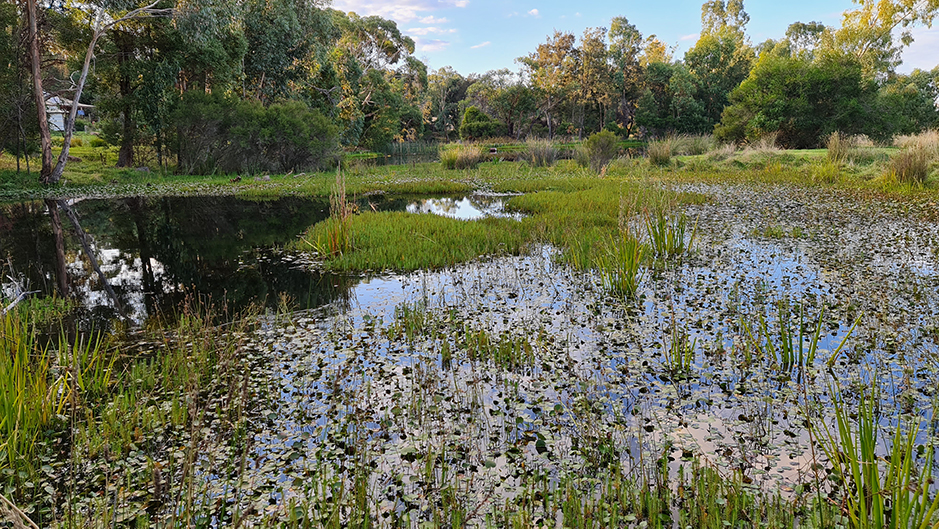
The same view (as above picture) in April 2023, looking north over Blue Lake Far South, Blue Lake South and through to Blue Lake in the distance.
The 200 metre long Blue Lake is not normally full in Autumn, 2021 was a flood year. The wetland plant growth seen here is more typical in spring.
While works elsewhere in the Redman Bluff Wetlands project continued through the years 2003 to 2006, it was not until 2007 that work recommenced on Blue Lake South and Blue Lake Far South.
2007: As had becoming common practice with building the Redman Bluff Wetlands, in 2007 getting the right type of earth to the right place was once again proving a challenge. This time top soil was needed to top dress Fire Wetland's Bank with good rich dirt that would grow wetland plants (on the inside surface) and a thick cover of grass on the top and outside surface of Fire Wetland's bank. The best option was to take the black sandy earth from Blue Lake Far South and Crescent Billabong, it was good rich soil. The removal of this soil made for an increase in the area that would be shallow water allowing a much larger area of wetland herbs to grow.
Removing the black soil by excavator and truck (and taking to Fire Wetland) made it possible for the establishment of the large area of wetland herbs shown in the above photo. The soil that was excess to the needs of Fire Wetlands was left in large piles ready for use in 2008 for building the north wall of Blue Lake South.

24th June 2007: - Blue Lake South has been dug out to the depth suitable for the foundation of its north wall. (Foreground of the photo).
The pile of sandy soils (mid-ground of the photo) is no good for building water tight dam walls or top dressing.
This pile stayed here until it was removed to build the wall of Bass Strait in 2008.
In the back ground, black soil from Blue Lake Far South and Crescent Billabong has been piled up, ready to take by truck to Fire Wetland.
The only other work to occur on the extension to Blue Lake (Blue Lake South and Blue Lake Far South) in 2007, was the digging out of the foundation area of the north wall for Blue Lake South. This was mainly exploratory, and apart from a narrow sand seam, we found good foundation material for the wall.
Under the rest of Blue Lake South, the earth that was scraped up into a pile by excavator, was very sandy and showed that there was a very thick layer of porous white sandy material that was not suitable for wall building. This sand seam is however the path through which the underground water was moving to form the soaks (minor springs) that have been included into the extended parts of Blue Lake.
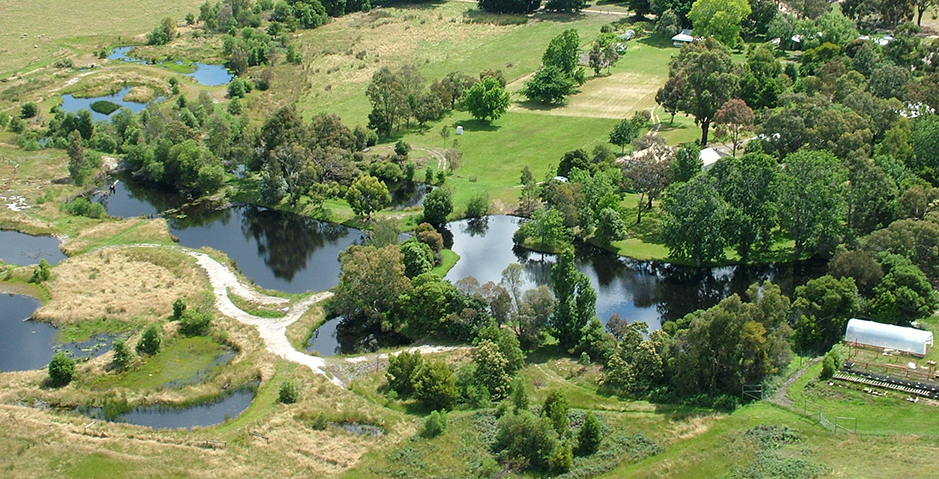
From right to left through the middle of the picture: Wetland Pant Nursery, Blue Lake, which is linked to Blue Lake South and joined to the left to Blue Lake Far South.
Bass Strait is to the right of the white sand tracks. These are the wetland ponds that were worked on in the 2008 Redman Bluff Wetlands building season.
(If your refer back to the Redman Bluff Wetland map higher up this page it will help you work out which pond is which in this aerial photo).
2008 was a big season for working on Redman Bluff Wetlands, lasting from the beginning of May to the end of August. The efforts were defined by the need to get rid of the white sands from Blue Lake South, find and move black sands to the north bank of Blue Lake South, and all the additional works to facilitate these priority activities.
To illustrate how complected a wetland building season could be, here is a calender of key dates for 2008:
24th April 2008: Already in April, many tons of white sand had been moved by tractor to build a ramp from Blue Lake South's eastern wall, towards where the eastern bank of Bass Strait would join the north east corner of Blue Lake's wall.
4th May 2008: The outlet pipe of Observatory pond is extended.
7th and 14th May 2008: (and dates before and in between) White sands continue to be moved to the form the bank of Bass Strait, which by the the 14th May has reached the the start of its spill way, and by the 27th almost joined onto the bank of the original Blue Lake.
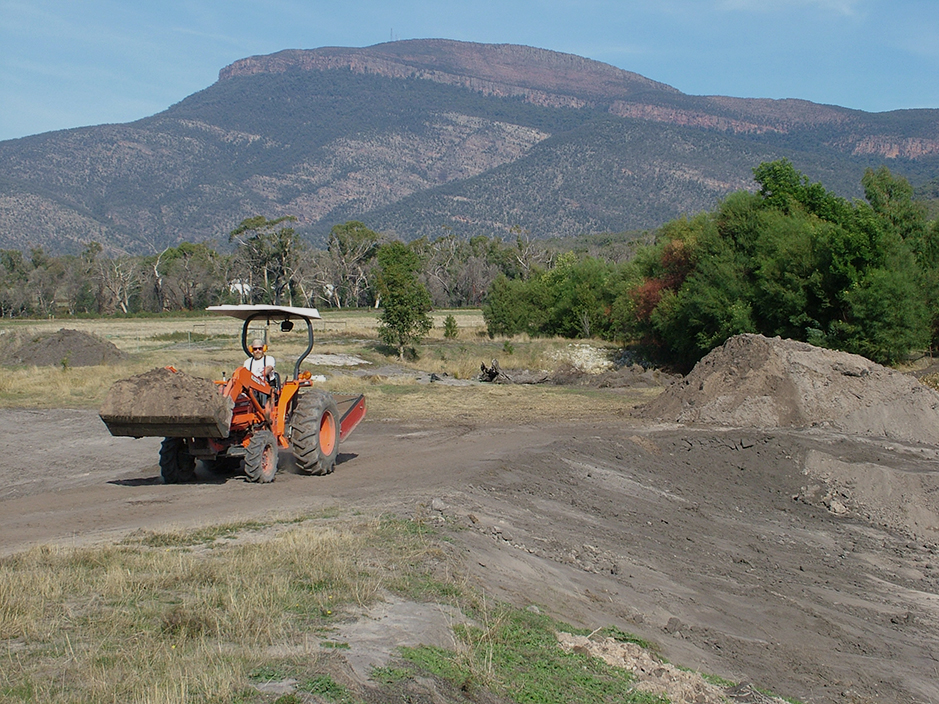
14th May 2008: Moving white sands and other lower grade earth to the new bank being built to make "Bass Straight Pond".
14th May 2008: Tadpole Soup is extended to the north.
15th May 2008: The trench is dug for the foundation of the new concrete spill way for Blue Lake.
16th May 2008: Form work is finished for the spill way of Blue Lake, and two concrete trucks worth of concrete is carted to the spill way in the excavator bucket. Seven large steeping stone rocks are set into the top of the concrete.
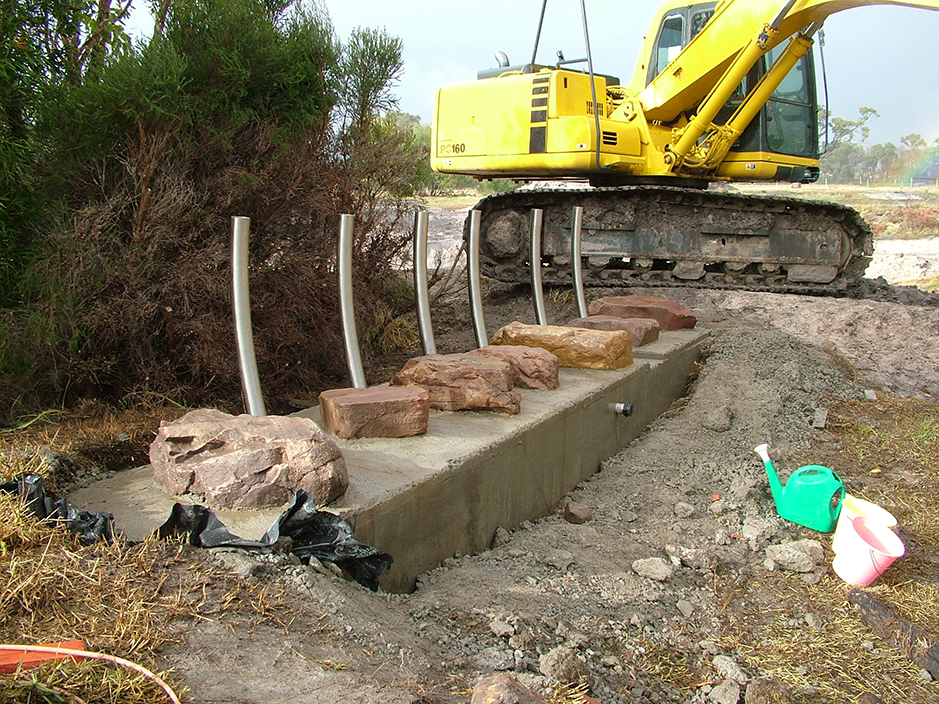
19th May 2008: The completed replacement spill way for Blue Lake, now made of concrete complete with steeping stones.
17th May 2008: A new concrete drop pipe spillway for Observatory Lake is poured.
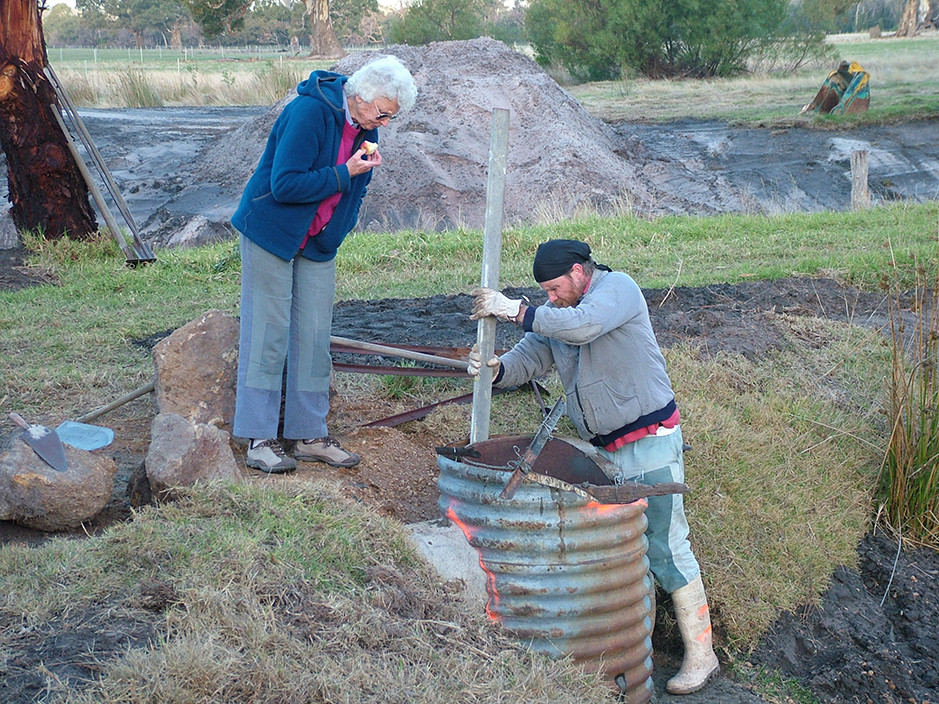
17th May 2008: Aileen Banfield (mum) intrigued by me (Aidan Banfield) filling of the form with concrete for the new spillway for Observatory Lake.
This new spill way raised the full hight of Observatory Lake by 2 feet, giving the semi aquatic wetland plants access to much better soils.
21st May 2008: The bank between Blue Lake and Blue Lake South is dug out, making the two parts into one lake. The moment this is done, the pressure is on to build the new north bank for Blue Lake South - a high risk decision.
27th May 2008: By the 27th, the in water slopes around the concrete spill way of Blue Lake have been top dress with rich wetland soil and the east bank of Observatory Dam top dressed to a flat surface, with a lower part to the south to form an an emergency overflow.
30th May 2008: The sand seam under the site for the new north bank for Blue Lake South (that had been dug out before the 14th May), is filled with very large stones taken from the old Blue Lake spill way to form a stable foundation.

30th May 2008: A family effort - Douglas placing stones into the trench where a sand seam had been dug out. This was done to form a solid foundation.
11th June 2008: A start has been made on building up the foundation of the east end of the north bank of Blue Lake South (over the rock in the above picture).
11th June 2008: Bass Strait bank is finished and Duel 110mm overflow pipes installed into Bass Strait Pond.
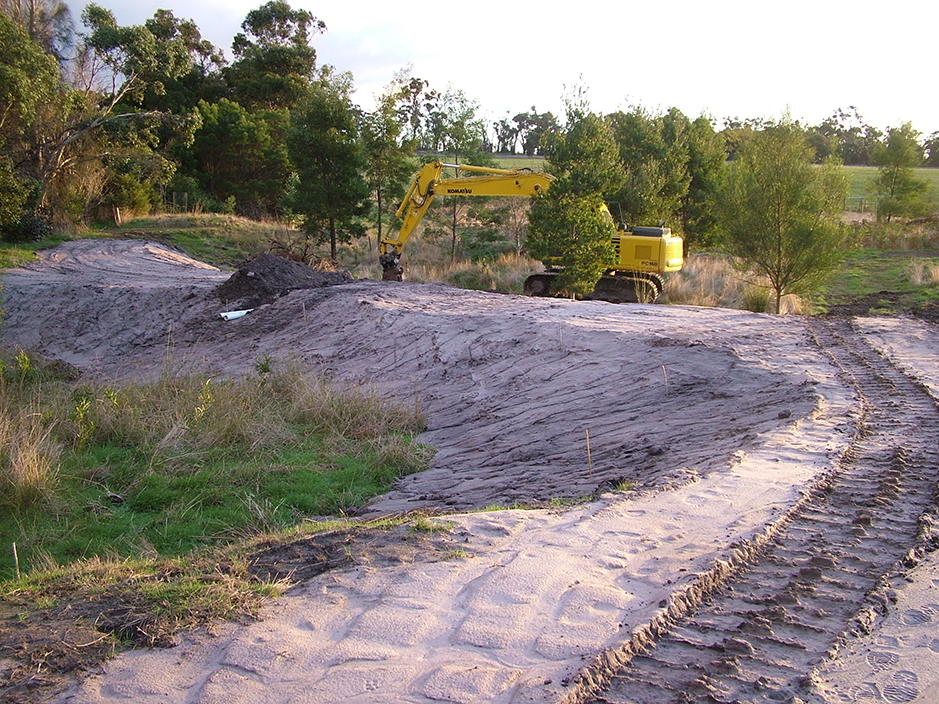
11th June 2008: Bass Strait ponds bank has been finished and over flow pipes are being installed. This bank is make of white sands that are not watertight.
Building this bank, and making Bass Strait pond was a creative way of getting rid of all this "waste" sands from Blue Lake South.
21st June 2008: The grass seeds that had be sown on the banks of Observatory Lake during June have germinated.
21st July 2008: Tadpole Soup has filled with water for the first time since it was enlarged in mid May 2008.
22nd June 2008: In the chase for good black soil to build the north wall of Blue Lake South, the shallow areas for Blue Lake Far South are further extended and the earth piled up into two hug heaps really to cart to Blue Lake South's growing northern bank.
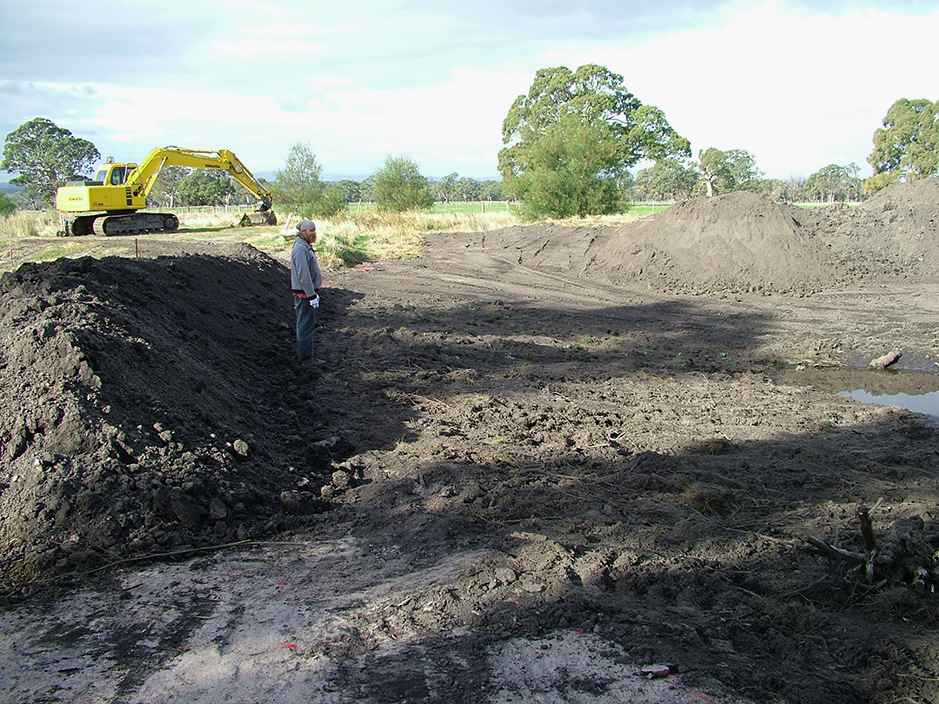
22nd June 2008: What it takes to build a good wetland pond... lots of dirt removed to create shallow slopes. This black soil will be used for building the north bank of Blue Lake South.
21st and 22nd June 2028: The black soil from Blue Lake South and Blue Lake Far South is moved to the base of the north bank of Blue Lake South. The muddy base is compacted with the tractor, with dryer soil being worked in to make a stable base on which to build the wall.

22nd June 2008: Starting to build the foundation for the full width of the north bank of Blue Lake South.
24th June 208: The north wall of Blue Lake South is slowly gaining hight.

24th June 2008: Layer by layer, the north wall of Blue Lake South was raised until we came close to running out of easy to reach wall building soil.
27th August 2008: Stock piled black soil from Blue Lake Far South is taken to Blue Lake South's northern bank. As the stockpiled soil is removed, Blue Lake Far South is smoothed out just ahead of the spring fed water rising in this section of Blue Lake.
27th August 2008: Building up the narrow upper part of Blue Lake South northern bank as a temporary bank. This was done in desperation, as there was not the available soil to properly compete the wall.
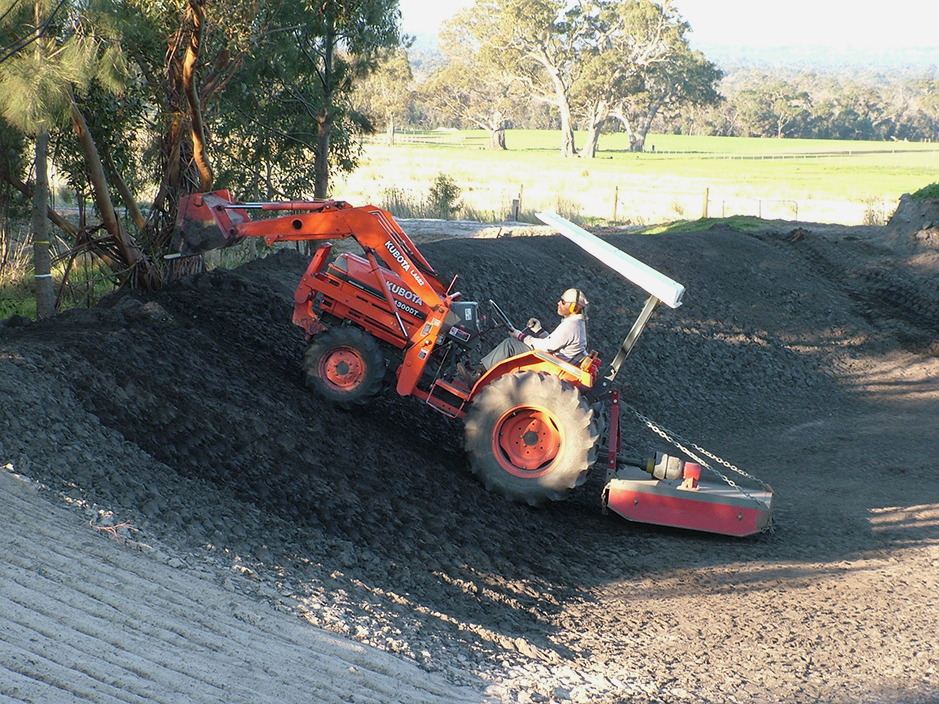
27th August 2008: As the full width of the north bank of Blue Lake South could not be build in 2008, a narrow bank was raised to full water hight.
29th August 2008: The north bank of Blue Lake South is competed (as best as possible) for 2008. The bank only just made the full water line... There was no ability to raise the bank any further, as all available sources of wall building dirt (where the ground was still dry and within a distance that was possible to move by tractor) had been exhausted.
29th August 2008: Most of the remain pile of white sand in in Blue Lake South is removed over the last days of August and taken to form part of the north bank of Pobblebonk Pond (north of Tadpole Soup).
1st September 2008: With 210mm of rain falling during July and August of 2008 on the catchment of Redman Bluff Wetlands, the water flow through the upstream wetland ponds had reached Observatory Lake and filled it by the end of August. Even with diverting as much water as possible around Observatory Lake and Blue Lake / Blue Lake South, there was only so much we could do.
On the first of September, the water started to overflow Observatory Lake through its new spillway pipe, flowing on into Blue Lake and soon into Blue Lake South. This brought to an end the wetland building season for 2008.
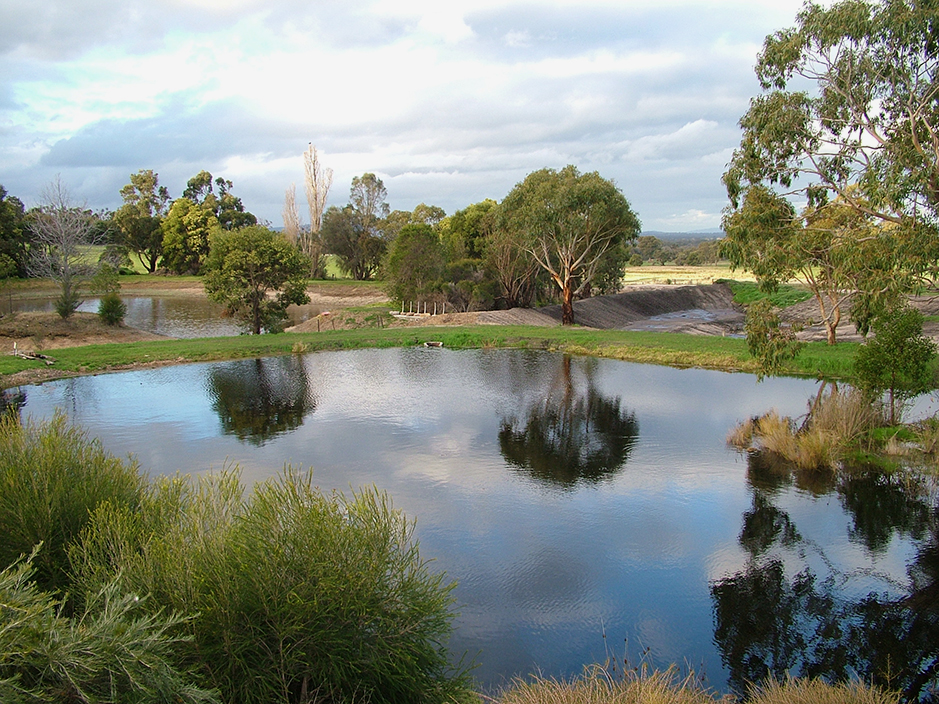
1st September 2008: Water fills and over spills through the new spillway pipe. Full level for Observatory Lake is now 2 foot higher than it was before 2008.
1st September 2023: Blue Lake Far South has filled with water from the spring that is under it.
3rd September 2023: Builders plastic and sand bags are add to protect the north bank of Blue Lake South.
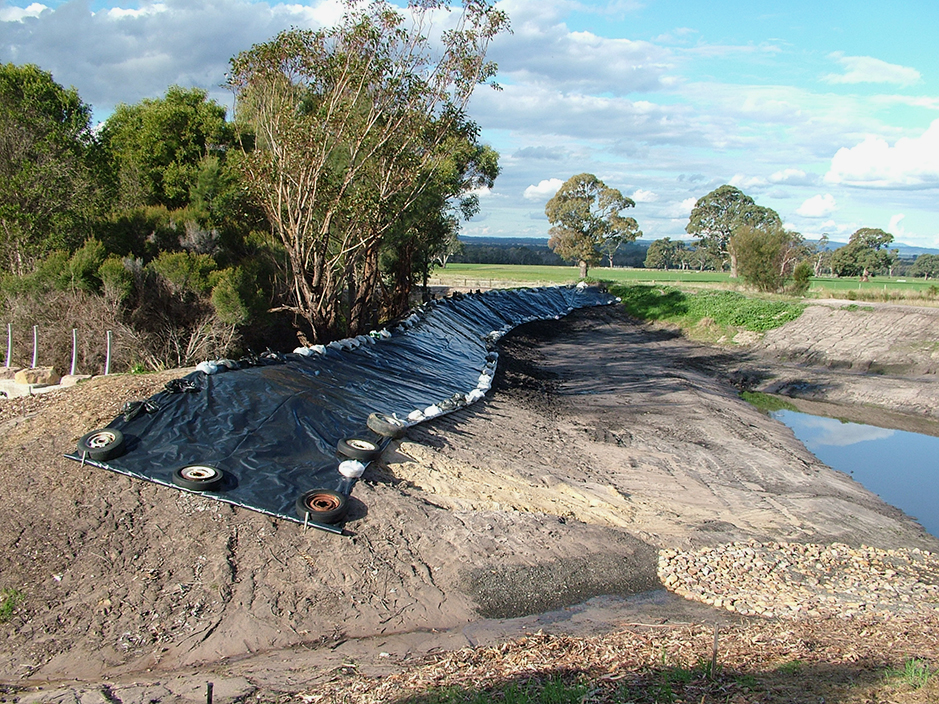
3rd September 2008: With the north bank of Blue Lake South only just raised to full water level line, plastic was used to try to protect the incomplete dam wall.
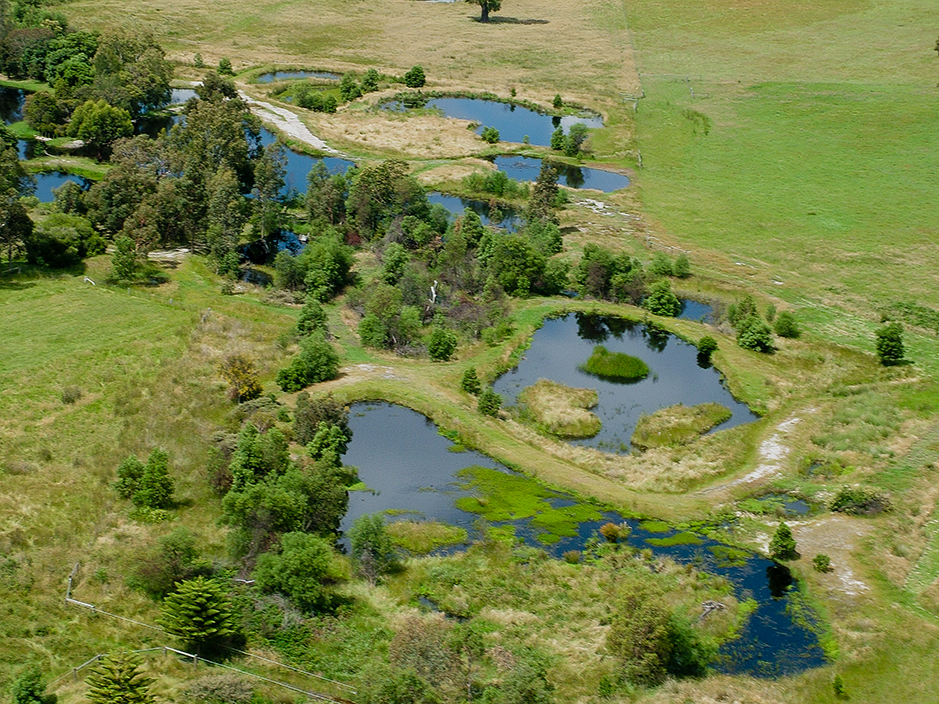
This photo was taken on the 4th December 2010 and shows the layout of the ponds after the major works undertaken in the 2008 wetland building season.
In the foreground of this picture Snipe Swamp (4th pond of the "sting of ponds") shows good development of the beds of wetland plants. It was competed in 2003.
In March 2009 what remained of the pile of white sand in Blue Lake South, was removed and used to build the north bank of Pobblebonk Pond. It was a bit of an exchange process, take white sand to Pobblebonk Pond bank, and return with good black soil (from the base of Pobblebonk Pond) to build up the base of the north bank of Blue Lake South.
Very little wall building material was obtained from Pobblebonk Pond and as such the desperate seas for wall building soil continued...
By the start of the 2009 wetland building season, there was no black soil left that could be harvested form the base of either Blue Lake South, Blue Lake Far South or Crescent Billabong. Blue Lake Far South was finished, and already wetland plants including Running Marsh Flower - Ornduffia reniformis and Woolly Water Lilly - Philydrum lanuginosum (also call Frogs Mouths) had been planted there. The options for wall building material were running out.
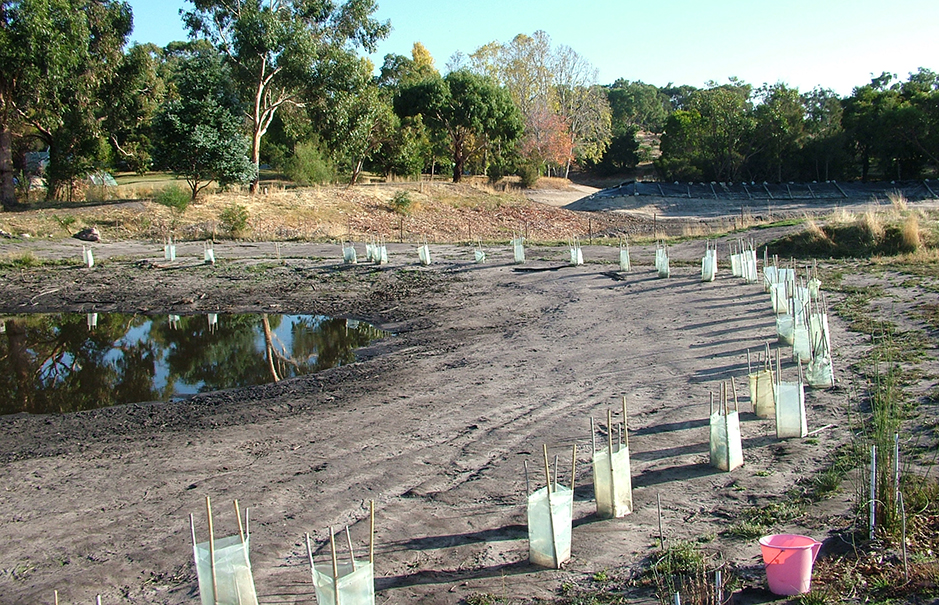
April 2009: Recently planted woolly waterlily - Philydrum lanuginosum (in plastic tree guards), running marsh flowers (no guards) and other wetland plants.
The decision was been made to expand Duck Dinner Wetland and Entrée Pond to the south, expanding their shallow water areas, giving the next source of material for Blue Lake South's north bank. Extraction of bank building soil from Entrée Pond was finished in June 2009, and in July 2010, what soil could be recovered from Duck Dinner Wetland was taken to the north bank of Blue Lake South. While these efforts raised the foundation of the wall a little further and then in 2010 raised the east end of the bank (where water had over flowed the bank in the spring of 2009), there was still a long way to go to finish the wall before it would be secure against flood flows.
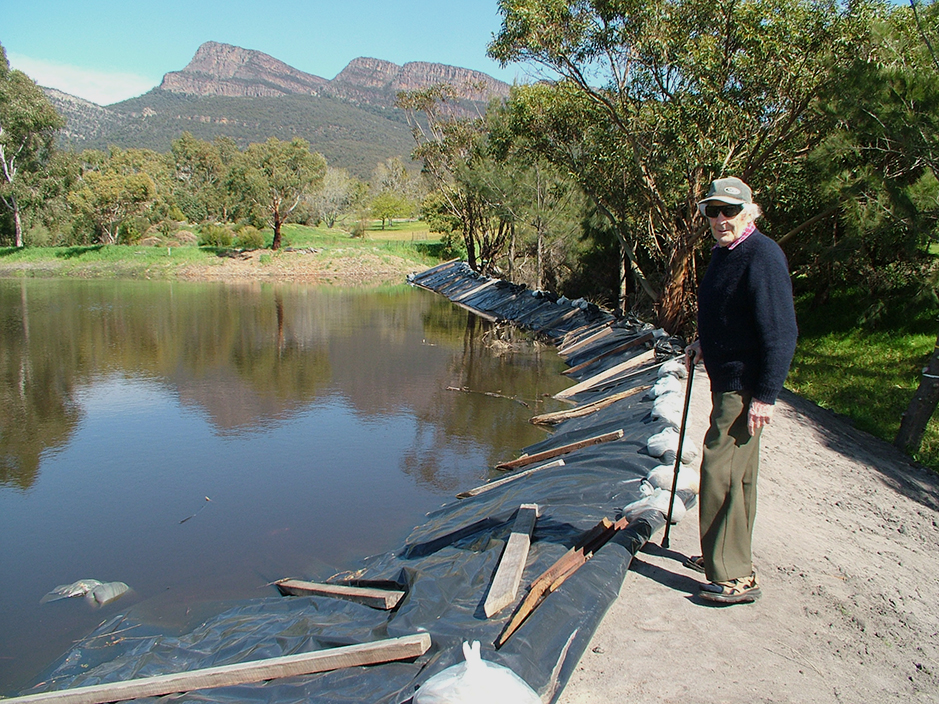
September 2008: The uncompleted north bank of Blue Lake South, protected by plastic from September 2008 during 2009, 2010, 2011 and removed in 2012 after the 2011 floods.
Tom Banfield (my dad at age 79) inspecting how the plastic was holding up after Aileen Banfield (my mum at 76) had moved the timber into place.
Floods - January 2011
Spring and summer of 2010 were really wet, with some big flows of water passing through Redman Bluff Wetlands, and the waters of Blue Lake lapping against the plastic protected top of the then narrow north bank of Blue Lake South; sometimes even over topping the bank. It was looking like things were going to hold up, but the rain kept coming.
Then on the 11th to 13th January 2011 we had 203mm of rain. This was too much... The water was over flowing a fifteen metre length of the north bank of Blue Lake South and soon found a weakness and cut into the bank.
A frantic effort was made by my family, Nessa, and our boys Henry and Douglas to sand bag the wall and to save as much as we could. While successful, we lost the top 30 centimetres of the wall in a narrow portion, setting the maximum water hight for Blue Lake to one foot lower for the remainder of 2011 and first half of 2012. It was too wet for the entirety of 2011 for any repair works on the wetlands to be undertaken, so it was not until mid 2012 that there was the opportunity for me to repair the damage and complete the building of the north wall of Blue Lake South.
--2011-floods--water-overbanking-blue-lake-south--cropped--ps939px-.jpg)
9th September 2010: Water flowing over Blue Lake South's northern bank, before the bank was partially cut through by the January 2011 floods.
Without the family effort to protect the bank, it would have completely washed away. Here Henry is testing the water shoot, watched by Nessa.
We were very fortunate in how little damage occurred to the 30 ponds of the Redman Bluff Wetland with the 2011 floods, however we did loose the entire 4 metre width of the spillway of Bass Strait (next pond down stream of Blue Lake), tuning that two and a half year old pond into nothing more than a mud flat. It too would be repaired in 2012.
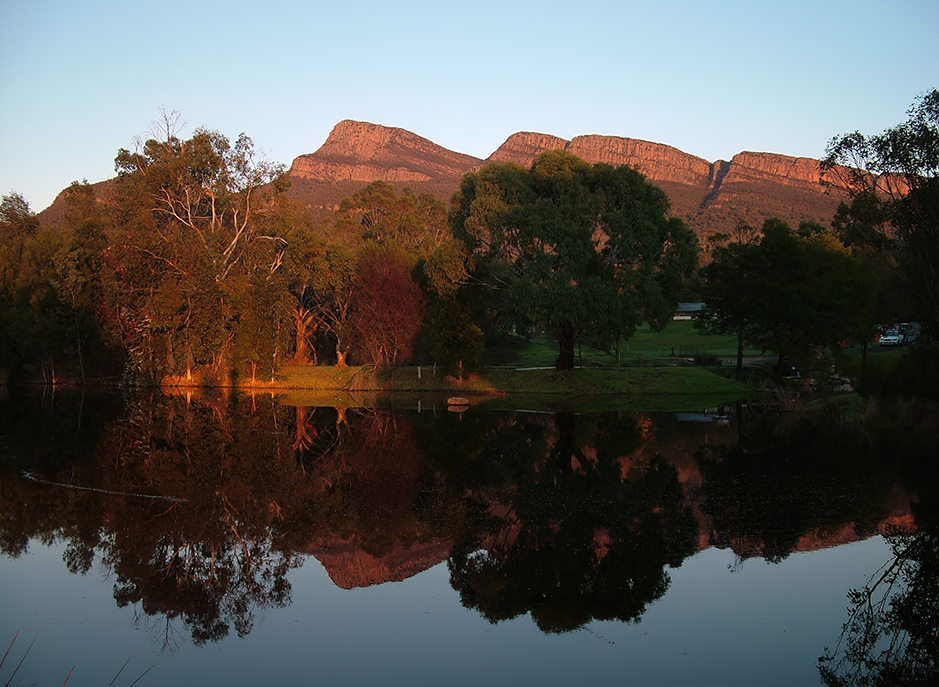
Winter sunrise 2016: Redman Bluff of the Grampians National Park reflected in Blue Lake South - Redman Bluff Wetlands at Grampians Paradise.
2012 Finishing the wall for Blue Lake South, the finish of building Redman Bluff Wetlands
The big rains that had persisted through 2010 and led into the floods in early January 2011 finally eased in the second half of January 2011 but the creek that flows through Redman Bluff Wetlands never stopped flowing that summer and Autumn. This lead to the most unusual situation that the wetlands remained full through the whole of summer and Autumn of 2011. This has only happened twice in the 23 years that the Redman Bluff Wetlands have been in existence. (The other time Redman Bluff Wetlands stayed full between summer and autumn is in 2023, following the 2022 flood year).
With the wetlands remaining full during 2011, it was not possible to repair the damage caused by the floods until the wetland building season of 2012.
Once the spillway of Bass Strait had been rebuilt in the first quarter of 2012, and the hole in the north wall of Blue Lake South was filled and compacted, I set about completing the north wall of Blue Lake South.
By 2009 I had run out of possible locations to extract soil from close to the wall (there were no extra shallow areas that could be made for the Duck Dinner Plain ponds), part of the reason the wall had never been finished.
In 2012 the solution to source wall building earth, was to use a very small truck in combination with our tractor with front end loader to cart dirt 280 metres from the Marsh Paddock Wetlands to the north bank of Blue Lake South. The process was slow. I would load the truck, drive it to north bank, dump it, drive the truck back. Drive the tractor with a full bucket the 280 metres to north bank, spread the dirt on the growing bank, drive the tractor back to get another front end loader bucket of dirt, drive back to north bank and then compact the the last truck load of spread dirt with the front wheels of the tractor with the bucket fully loaded. Then repeat the process, again and again for more than 100 truck loads.
This process of moving dirt to finish the bank lasted a little over a month, between late April and early June of 2012. At its completion, the last bank of the Redman Bluff Wetlands was completed, bringing the building of the Redman Bluff Wetland to its conclusion... We'll almost.
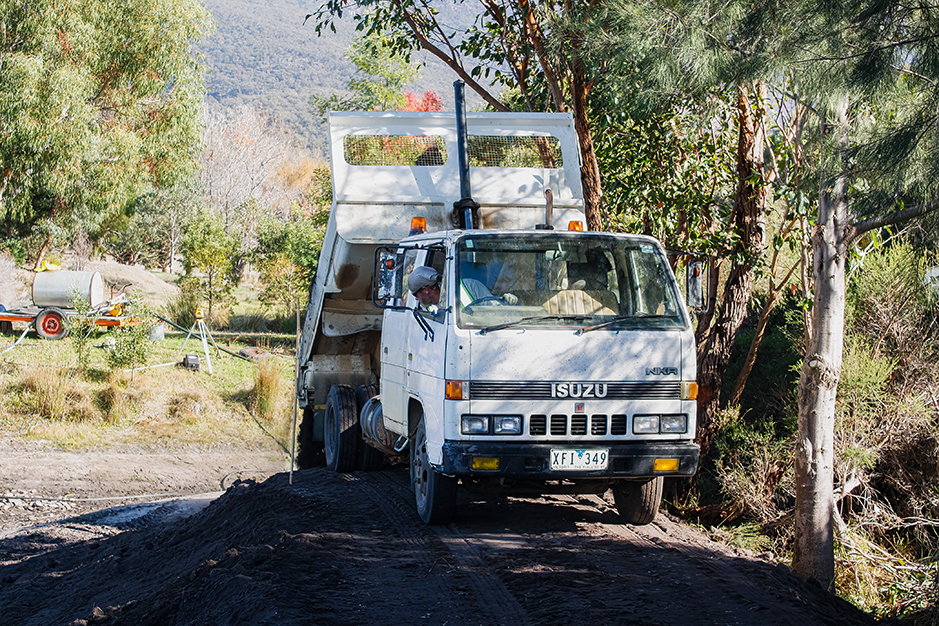
Late April to early June 2012: Carting dirt to the north bank of Blue Lake South to finish building the last bank of Redman Bluff Wetlands.
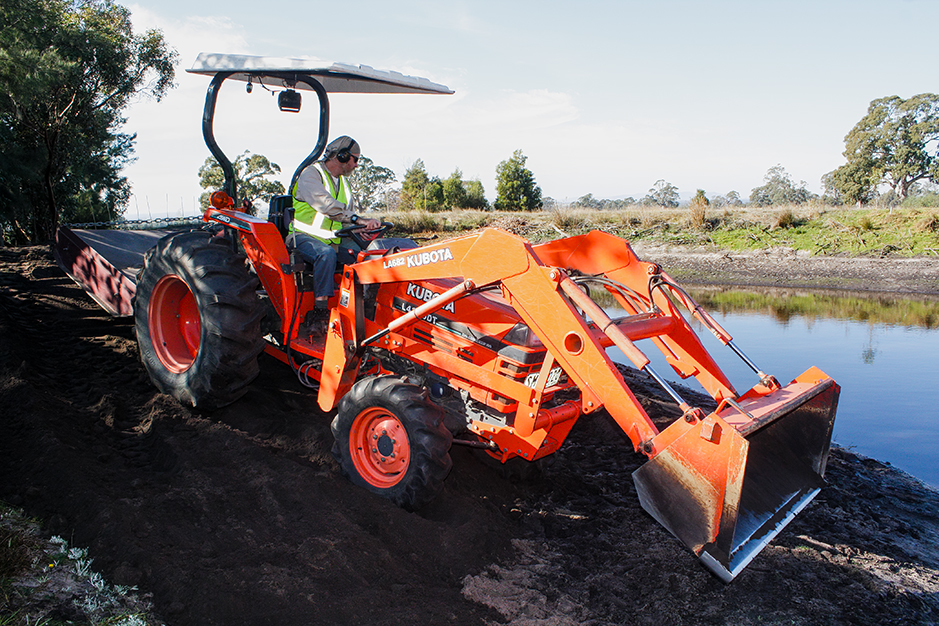
Spreading and compacting the black soil that had been brought up by truck from the Marsh Paddock Wetlands by truck (see the above photo).
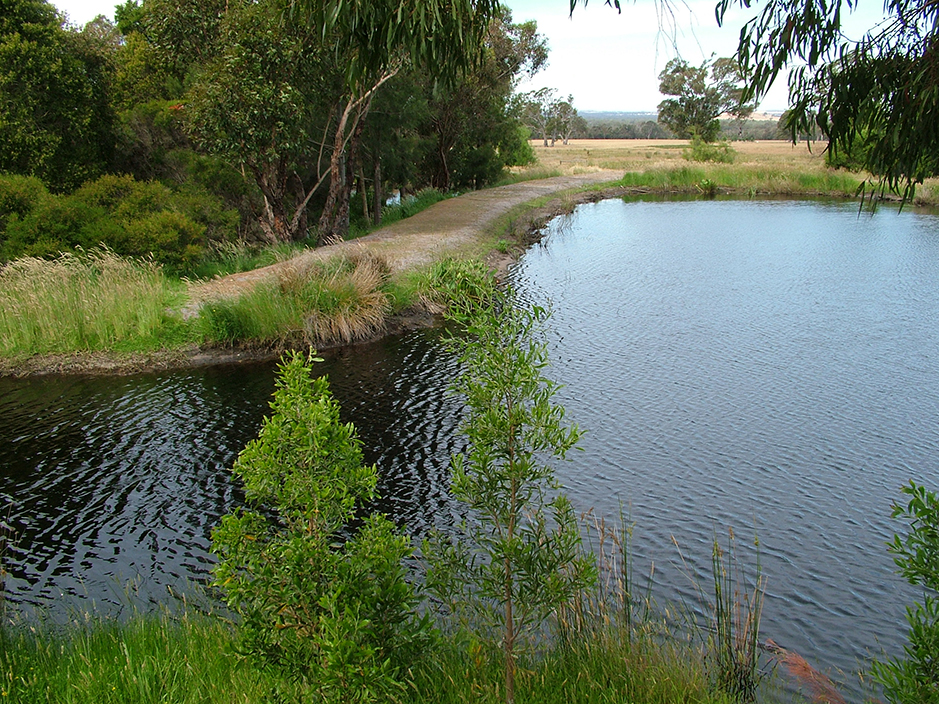
25 November 2011: The north bank of Blue Lake South is completed and already wetland plants are starting to establishing in the rich soil.
The next picture down the page shows you the wetland plants growing on the closest corner of the bank as there were in spring of 2022.
These wetlands plants have grown from seeds, roots (rhizomes) and young wetland plants that were in some of the grassy soil that was used to top dress the bank.
Some of the grassy soil came from Duck Dinner Wetland. The last few tractor loads came compete with wetland plants in 2012, effectively transplanting then from Duck Dinner Wetland.
2012 to 2023: The growing of Redman Bluff Wetlands into an amazing ecosystem:
By 2012, 12 years had passed since the start of building the 30 pond Redman Bluff Wetlands.
By the end of the 2012 wetland building season, all the ponds had been created and efforts made over the years to plant and establish the wetland plants that would transform Redman Bluff Wetlands into the incredible rewilded ecosystem that it is now in 2023.
For most of the ponds it has taken around 10 years since each one was completed (and the starting of establishing the wetland plants in each pond) for them to develop into their full potential of a wetland ecosystem supporting lots of native creatures. While planting and encouraging natural regeneration got the process underway, it has taken time for the wetland plants to flourish and create massive beds of aquatic and semi aquatic vegetation.
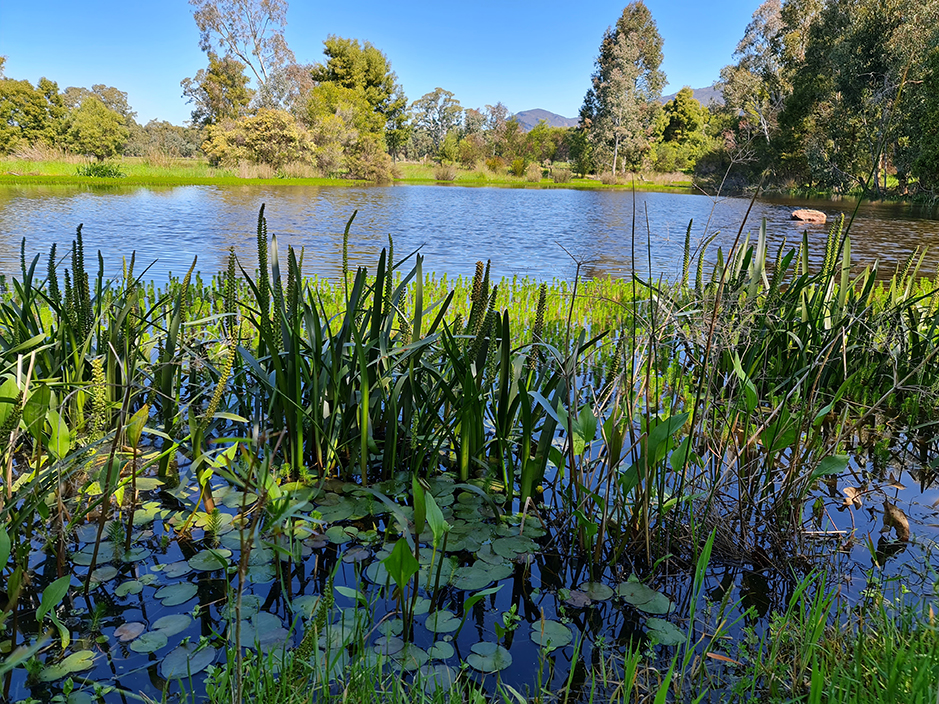
Spring 2022: A Thick bed of a community of 5 or more species of native wetland plants growing on the edge of the north bank of Blue Lake South.
Looking at the pictures of how Redman Bluff Wetlands is now in the 2020's, it would be easy to think all that is need to create a wetlands is just made the ponds, the plants will then get themselves going and the animals and creatures will follow.
While there is a small amount of truth to this, there was a lot of encouragement needed to help the plants to get themselves going. Once the wetland plants were establishing, the native animals and bird did arrive.
The efforts and encouragement that was needed was all about giving the right conditions for the wetland plants to flourish, thus creating habitat for the native wildlife.
Wetland plants are the cornerstone of a working freshwater wetland ecosystem.
To successful establish wetland plants
there were several steps we took.
Here is the 10 step process I used to guarantee big successes in establishing wetland plants.
Step 1: Dig wetlands that have lots of very shallow water. Many semi-aquatic plants love water that is 15 centimeters or less in depth.
Step 2: Make loose rich deep soil for the wetland plants to grow in (both within the water and surrounding wet soils).
Step 3: incorporate lots of organic material into the soil. With projects undertaken off property, we included up to 50 present wood chip / leaf material. For Redman Bluff Wetlands the best source of organic material was dirt full of grass sods scraped from areas where I was going to build other ponds.

9th July 2010: The finished surface of north bank of Blue Lake South is covered with grass sod / soil mix taken from an extension to the shallow areas of Duck Dinner Wetland.
This carpet of grass and soil stabilized the surface from wave erosion and formed the perfect bed for growing semi-aquatic wetland plants in. It even had wetland plants seeds in it.
Step 4: Add nutrients (fertilizer). Wetland plants are hungry. Newly constructed wetlands need lots of nutrients to help wetland plants establish rapidly. At least put some slow release fertilizer under each plant, or mix into the soil when adding organic material.
Step 5: Mulch heavily. A thick carpet of mulch not only conserves moisture, it provides nutrients, feeding the plants over time. Leaves, wood chips, hay, cut grass and tree pruning are all good.
Flooding thick grass in-situ or planting Rye Core grass (then allowing it to be flooded) all works well.
For Valley Lake we laid down a carpet of 30 centimeters of cut grass. For projects on other properties we used a 15 centimeter deep carpet of wood chips - it worked well. But the very best was when I left the tall thick grass in place in the shallow water areas of Duck Dinner Wetland. The grass dyed (being flooded) but the wetland plants loved it a grow on this ground faster than anywhere else.
Step 6: Plant lots of wetland plants. This should seem pretty obvious, but plants cost a lot when you are looking at needing thousands or tens of thousands of them... We started our own nursery to get the wetland plants we needed.
Wetland plants grow best when surrounded by other wetland plants... Sometimes the best way to achieve this was to clump the plants together. They would grow thick, then spread out over the rest of the pond over the following years. This was the most successful planting strategy within Duck Dinner Wetland. (Other strategies were used in other ponds).
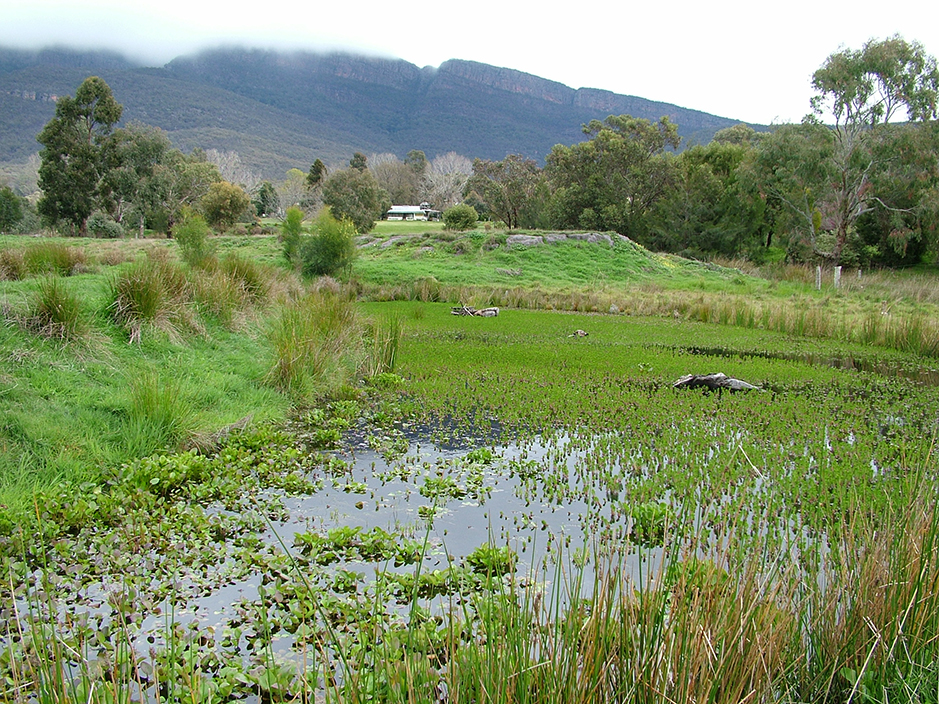
22nd September 2005, 2 years after planting 3000 upright water milfoil Myriophyllum crispatum in Tadpole Soup. 1000 plants were lost to wild ducks as there were no plant guards.
However with 25 plants per square metre, the remaining plants were able to rapidly proliferate and covered the pond during the second year of spring growth.
Step 7: Protect the plants with guards. Wetland plants are important food for many wetland birds - its what attracts certain species to wetlands. This is wonderful once the wetland is established, but I know of wetland projects where 100 percent of the planted wetland plants were lost to ducks and other grazing birds. Plastic or wire tree guards, a wire cage (for clump plantings) or vine or orchard bird netting over heavy wire frames all work.
Step 8: If you are on a farm, exclude sheep, cattle and other stock from the wetlands. More likely than not, they will eat all the wetland plants, pug up the soil and all you will be left with is a muddy pond.
Step 9: Watering. For seasonal wetlands (or shore areas that dry out) add water through the first summer and autumn by sprays or occasional flooding to keep the soil a little moist. Mulch also helps keep the wetland plants moist and alive though the first summer.
Step 10: And finally once the wetlands are well established with thick beds of wetland plants, enjoy watching all the native birds and animals that are attracted to the wetlands and enjoy listening to the frogs and other creatures.
Our Redman Bluff Wetlands is a most amazing location to watch and listen to lots of the native wildlife and creatures.
Watching, listening to and photographing the wildlife of Redman Bluff Wetlands
while staying at Grampians Paradise Camping and Caravan Parkland.
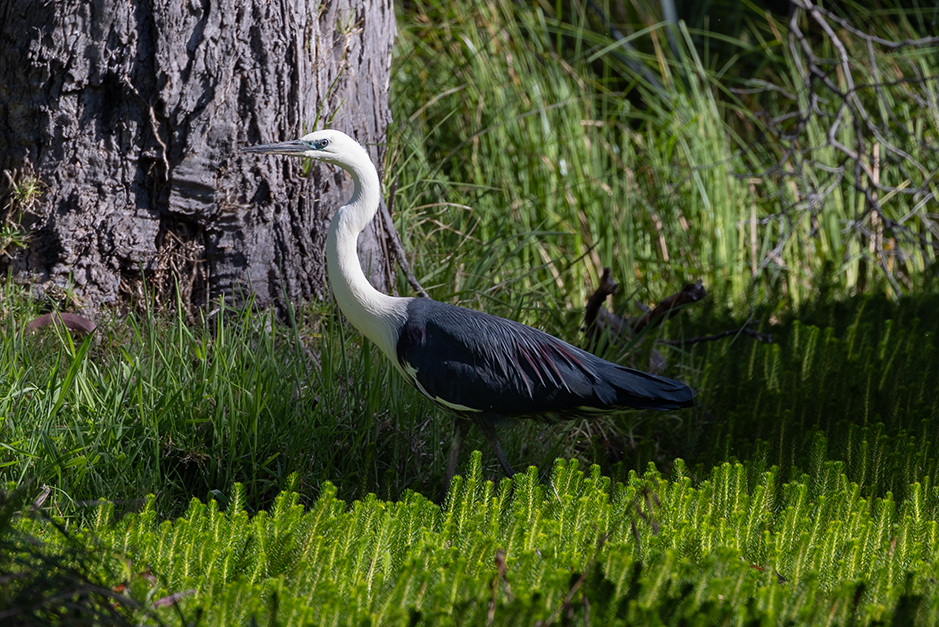
1st October 2023: White-necked heron hutting for yabbies (freshwater crayfish) or frogs in Observatory Pond within the beds of semi-aquatic wetland plants.
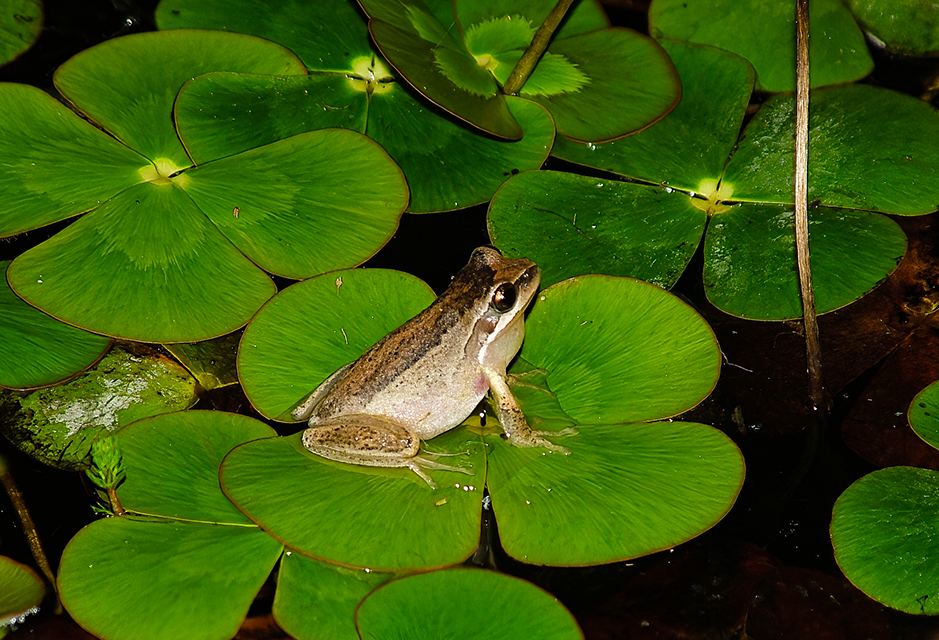
24th January 2011: Southern brown tree frog Litoria ewingii sitting on a smooth nardoo Marsilea mutica, with its attractive 4 leaf clover look, in Valley Lake.
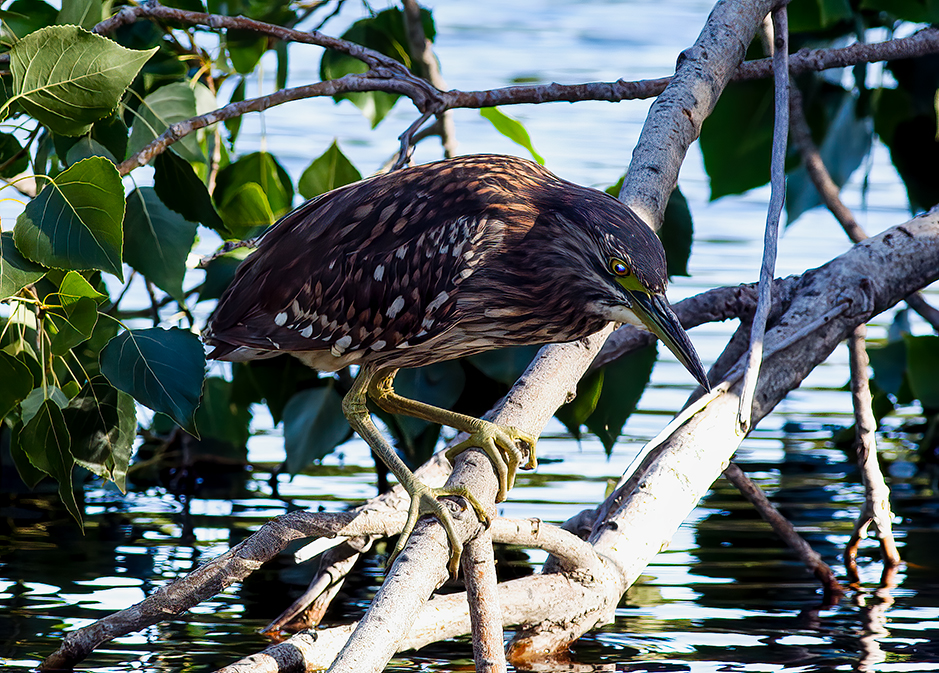
December 2009: Night heron hunting the creatures (fish and tadpoles) that call the waters of Blue Lake home.
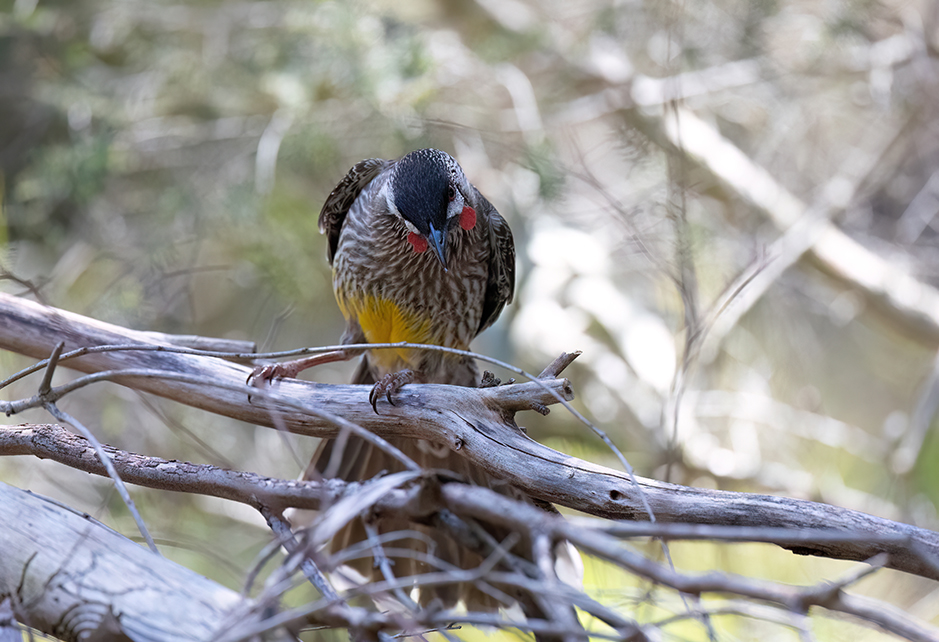
10th October 2023: Red wattle bird carefully watch who is below on the ground, from his/her perch beside Wattle Wetland (Pond 2 of the string of ponds).
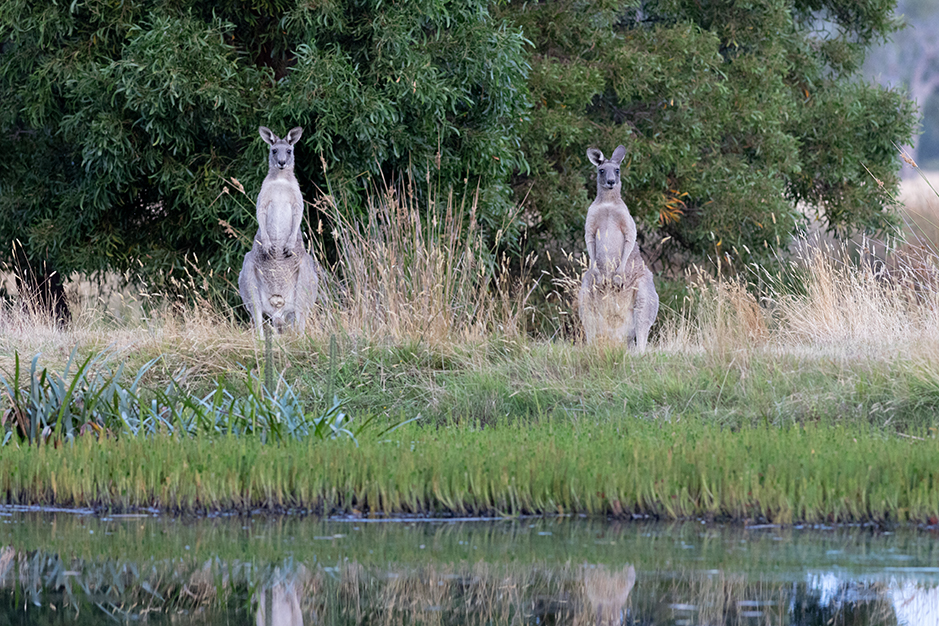
15th February 2023: Two large male kangaroos watching us watching them on an Exclusive Wildlife Stay at Grampians Paradise.
The kangaroos (and swamp wallabies) love the green grass and cover in and about Redman Bluff Wetlands. They also graze on the wetland plants.
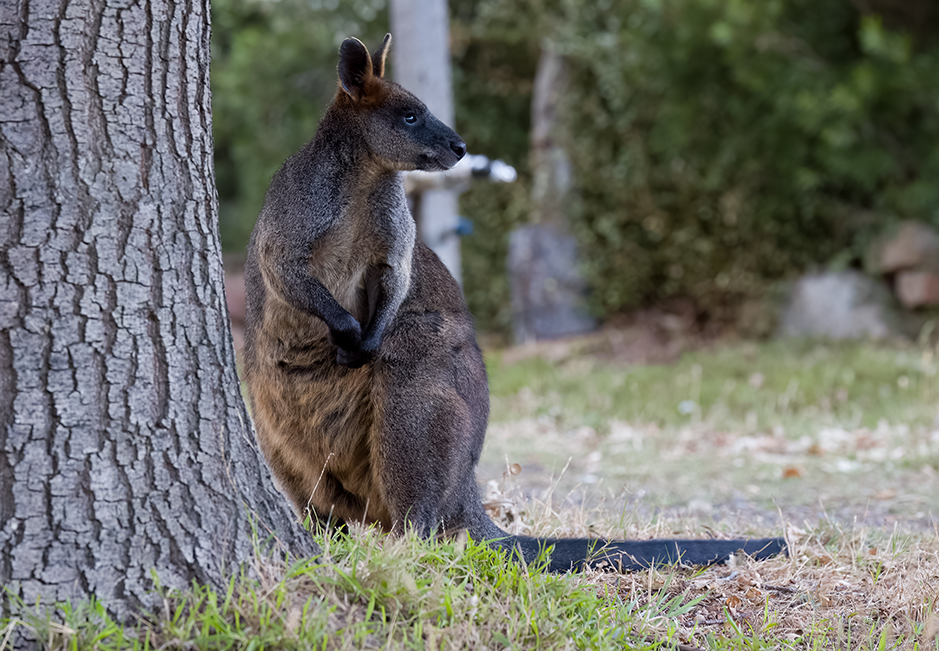
1st April 2023: Swamp wallaby on Parkland 10 (P10), an unpowered camping site at Grampians Paradise. He is looking towards Redman Bluff Wetlands.
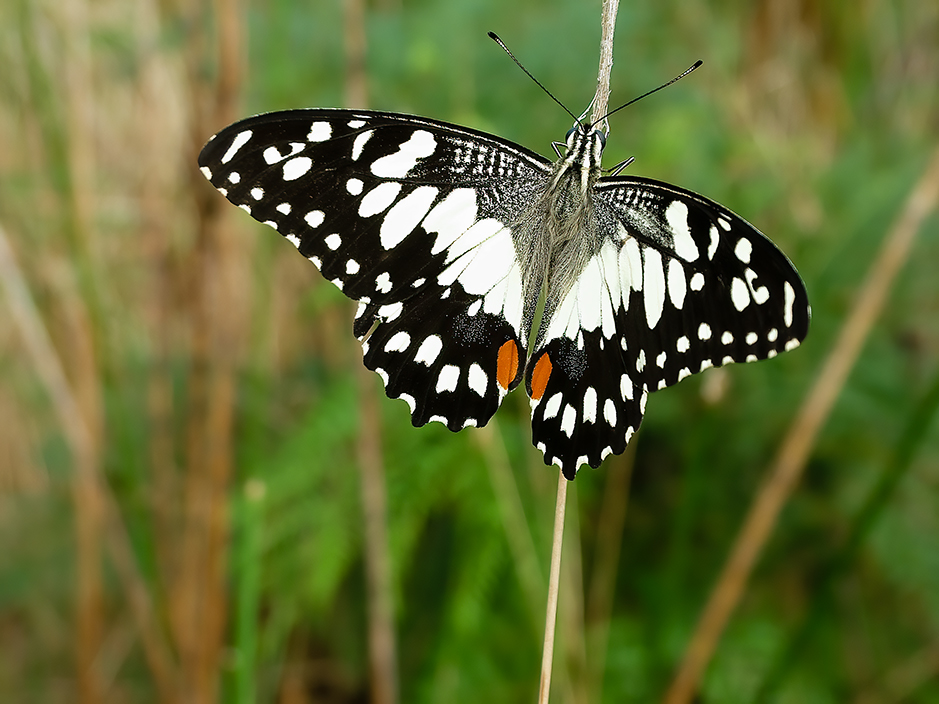
Photographed 14th January 2011: A beautiful butterfly that goes by the name of "chequered swallowtail" - Papilio demoleus
I found this beautiful creature beside Snipe Swamp (Pond 4 of the string of ponds) of Redman Bluff Wetlands, in amongst native rushes and sedges.
It was on the top of and old Carrex appressa "tall sedge" flower spike about ten or so metres away from the waters edge in an area wet ground plants.
Guided wildlife watching at Redman Bluff Wetlands and Grampians Paradise
Spending time at Grampians Paradise, watching the native birds and animals that frequent our Redman Bluff Wetlands and Grampians Paradise Camping and Caravan Parkland is a really rewarding way to pass time for those of you who love their wildlife and native creatures.
The best time to watch our wildlife is when the camping ground is quieter. During times outside of the long weekends and school holiday times there are usually less people staying at Grampians Paradise, and these quieter times our wildlife tends to spend more time in the camping ground and wetlands beside the camping ground.
During school term times, we are normally closed on Mondays, Tuesdays and Wednesdays, however you are more than welcome to give us a call (or send us an email) to see if we can open our booking diary for particular mid week school term dates. We often do accept bookings for mid week dates during school term times on request, but bookings for "closed days" can only be made over the phone or by email.
Because it is not possible to make online bookings for days where we would usually be closed**, there are inevitably fewer people staying at Grampians Paradise on mid week days, making it all the better for seeing our wildlife and hearing and seeing our native birds.
** Once closed days are opened for a booking (excluding Exclusive Wildlife Stays), we will open up online bookings for those days.
To get the most amazing experience with watching our wildlife that lives within the camping ground and Redman Bluff Wetlands, you need to stay when no other guests are staying. This is when the native animals and birds are most present.
To facilitate being able to stay at Grampians Paradise with no other guests than yourself, or your small group, we offer Exclusive Wildlife Stays at Grampians Paradise, which include guided wildlife walks and wildlife watching.
What is an Exclusive Wild Life Stay at Grampians Paradise?
There is lots of information on Exclusive Wildlife Stays on these pages:
Exclusive Wildlife Stays information page,
and the Exclusive Wildlife Stays Welcome Package where there is more detailed information.
Stories from some of those who have experienced an Exclusive Wildlife Stay
The History of the Creation of a wildlife haven at Grampians Paradise
and the story page about my letter to David Attenborough and the letter he sent in reply
Terms and conditions for bookings and stays at Grampians Paradise
in addition to those listed on the Exclusive Wildlife Stays - Cancellation Policy page:
Sorry no Pets.
Rates effective 1/3/2022 (Including rates for Exclusive Wildlife Stays) and subject to change without notice.
There is some important and really useful additional informational that you need to read before making a booking to stay at Grampians Paradise Camping and Caravan Parkland in our Terms and Conditions. We have written and formatted our terms and conditions so that they are easy to read and understand. The terms and conditions information includes information on how you can pay, deposits, what to do if you need to cancel or change the details of your booking, night time noise restrictions after 11:00pm, when and where you can have camp fires and lots of other useful information. Click here to read our terms and conditions.
Grampians Paradise offers a retreat from the pressures of busy life — a place to relax and to relate to a rich and varied country environment. You can take time to sit and enjoy the views of lakes and mountains and listen to and watch the native Australian birds and animals.
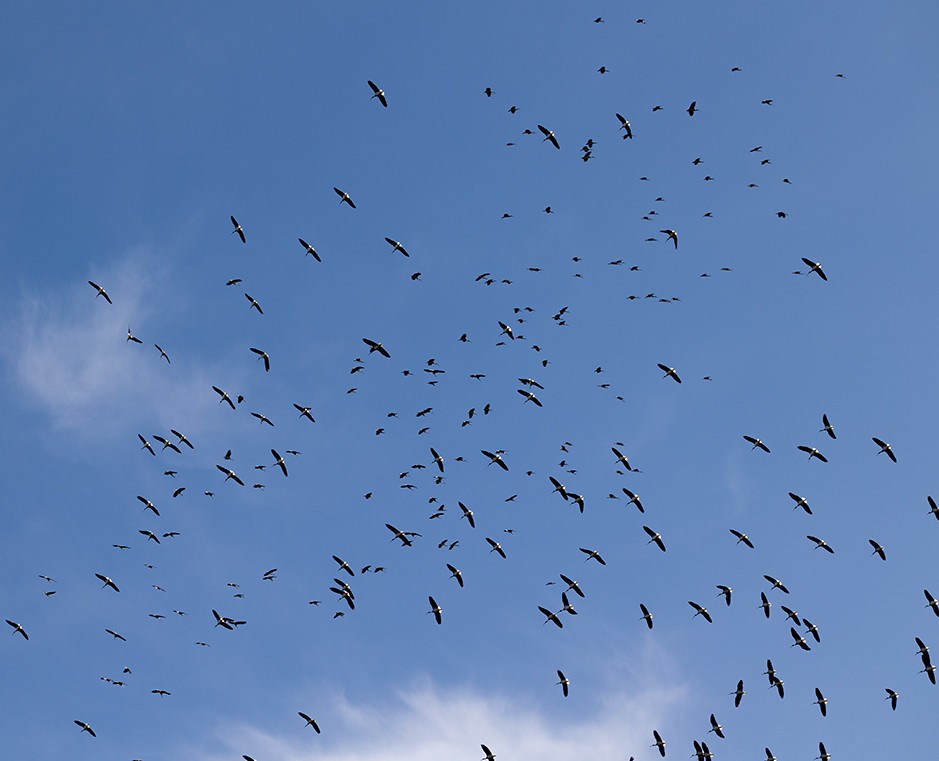
27th August 2023: 225 Straw-necked Ibis soring on the rising air over Blue Lake of Redman Bluff Wetlands at Grampians Paradise.
